The debut of the Haier brand in the European television market with the K85F model feels quite rushed, and after thorough testing – almost unfinished. Analyzing this product leads to a fundamental conclusion: its biggest problem is not the quality of the panel used. Considering the price segment, it is simply average, with typical VA technology advantages such as high contrast and equally typical disadvantages like poor viewing angles. What truly disqualifies this model as a home entertainment centre is the glaring lack of engineering and, above all, software refinement. The list of shortcomings is long and starts with the first contact with the device. Shoddy assembly, which could have been avoided at the quality control stage, a terribly optimised and poorly translated Google TV system, or annoying issues with basic functions like pairing the remote – all contribute to an impression of a product that seems to have been launched without due diligence. Catastrophic picture quality in HDR mode, resulting not only from low brightness but also from a complete lack of smart adaptation to the signal, only adds to this disappointing picture. However, it turns out that this model has a surprising second face. Just looking at it not through the lens of a home television, but rather as a large and inexpensive display for special tasks, shifts its shortcomings to the background, bringing unexpected strengths to the forefront: a fantastically functioning media player with USB, excellent font readability from a PC, and access to a vast array of applications. In such a role – as a screen in a conference room, hotel lobby or a simple advertising player – the Haier K85F performs surprisingly well. For a typical user searching for a reliable and simply well-functioning television for the living room in 2025, however, the Haier K85F is a proposition that is extremely hard to recommend with a clear conscience. It is a product full of contradictions, which fails in too many areas in its primary, intended function as designed by the manufacturer.
- Matching (Score)
- Our verdict
- TV appearance
- Where to buy
- Contrast and black detail
- HDR effect quality
- Factory color reproduction
- Color reproduction after calibration
- Smoothness of tonal transitions
- Image scaling and smoothness of tonal transitions
- Blur and motion smoothness
- Console compatibility and gaming features
- Input lag
- Compatibility with PC
- Viewing angles
- Daytime performance
- Panel details
- TV features
- Apps
- Playing files from USB
- Sound
Haier K85F vs Haier Q80FUX
Direct comparison
K85F / K85FUX


Panel type: LCD VA
Resolution: 3840x2160
System: Google TV
Model year: 2025
Complete the survey to find out the result

Panel type: LCD VA
Resolution: 3840x2160
System: Google TV
Model year: 2025
Complete the survey to find out the result

Overall rating
5.4
5.8
Movies and series in UHD quality
5.2
5.9
Classic TV, YouTube
5.2
5.6
Sports broadcasts (TV and apps)
4.6
4.7
Gaming on console
6.4
6.7
TV as a computer monitor
6.0
6.0
Watching in bright light
4.1
4.8
Utility functions
5.5
5.6
Apps
9.6
9.6
Sound quality
4.8
5.5
Complete the survey to find out what fits your preferences
Advantages
Low input lag, great for gaming
Surprisingly good file player from USB
High contrast and decent blacks (VA panel)
Good text readability in PC monitor mode
Presence of features for gamers: ALLM and VRR
Access to many apps thanks to GoogleTV
Very good native contrast and decent black (thanks to the VA panel)
PFS / QLED Filter - Wide colour gamut (about 95% DCI-P3)
Remarkably low input lag (below 10 ms at 120Hz and about 12 ms at 60Hz), making it a great choice for fast-paced games.
Support for 120Hz at lower resolution (Full HD) and the presence of VRR and ALLM
Support for Dolby Vision
Well-functioning file player via USB
Presence of analogue headphone output (jack)
Disadvantages
Catastrophic image quality in HDR mode
Low quality of workmanship and fit of materials
Slow, glitchy, and poorly translated Google TV system
Very poor sound quality from built-in speakers
Problematic remote (and no batteries included)
Poor viewing angles
Low brightness and weak anti-reflective coating
Low colour gamut coverage
The image is quite "blown out" in HDR
Google TV software is full of bugs, poor translations, and issues
Lacks any image enhancement features (noise reduction, gradient smoothing)
Average brightness
Flat, bass-less sound
High input lag in Dolby Vision mode for gaming
Weird and not very ergonomic remote
Our verdict
The Haier Q80FUX television is one of the most schizophrenic propositions we have had in our editorial office for a long time. On one hand, we have a solid piece of equipment: a VA panel guaranteeing deep blacks, as expected for this segment, and a QLED quantum filter that can indeed generate juicy, eye-catching colours. This is the foundation on which a truly competitive mid-range receiver could have been built. Unfortunately, all this potential of the matrix is systematically undermined by the software, which is a real anchor for this model. The biggest Achilles' heel of the Q80FUX is its total capitulation in dealing with HDR10 materials. The electronics seem to completely misunderstand how to interpret the signal, resulting in it consistently blowing out the brightest parts of the image, turning them into a flat, milky spot. Adding to this is the Google TV system, which – while functional – is unstable, full of bugs and annoying oversights, giving us an image of a raw product that clearly reveals the producer's lack of experience. Just when we were about to write this model off, we discovered its surprising niche. After connecting a console, the Q80FUX undergoes a transformation. It turns out that this television offers remarkably low input lag, fully supports VRR, and can handle a 120Hz signal in Full HD resolution. In the gaming world, where responsiveness is everything, these parameters put it in a very good light. So we are dealing with a device of very narrow specialization. It is not a universal living room television – it lacks stability and, above all, any correctness in handling films. It is rather a budget, large-format monitor for gamers, who can consciously forgive it all the software flaws in exchange for those few key attributes for console/PC at a relatively affordable price.
TV appearance


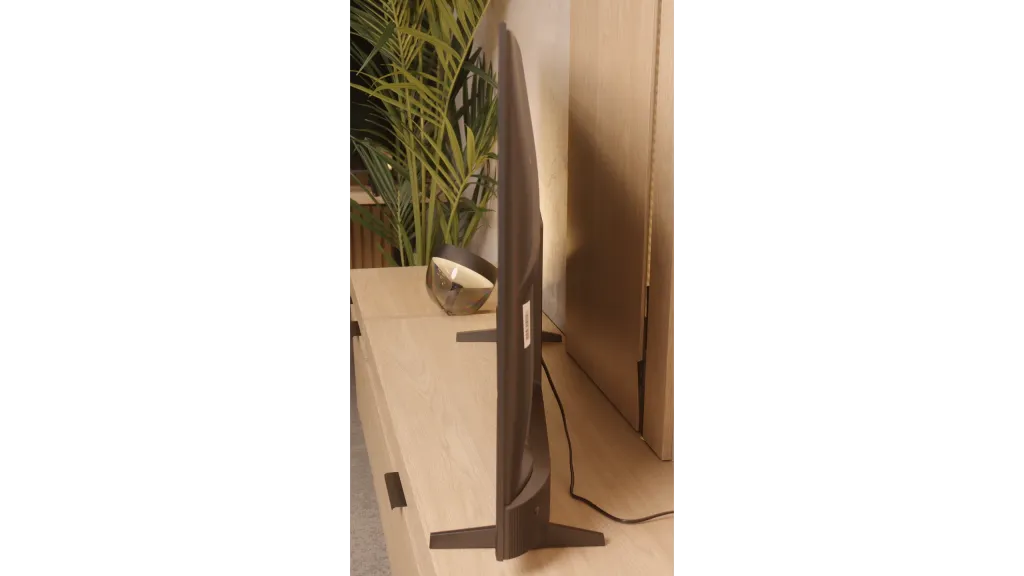


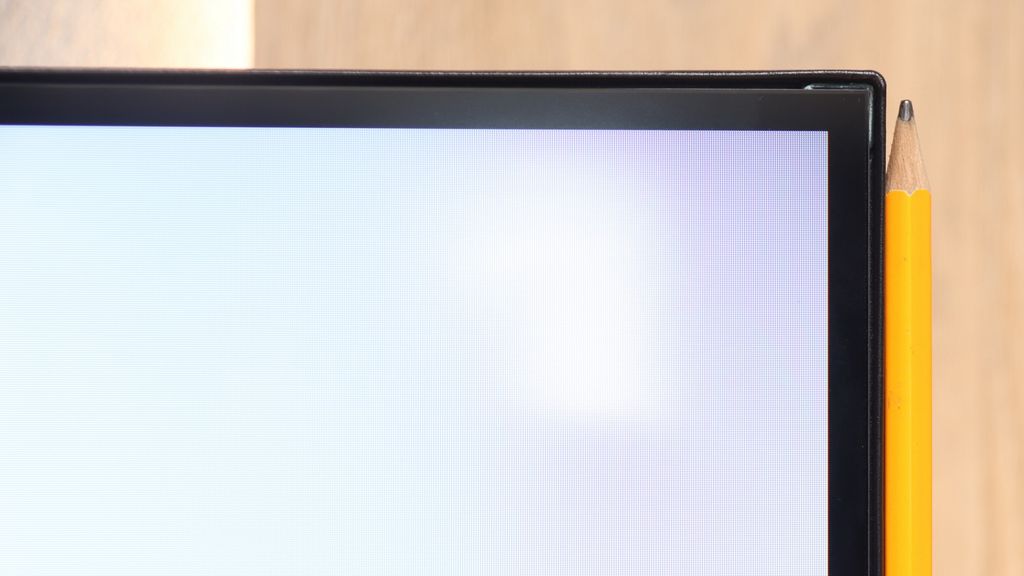
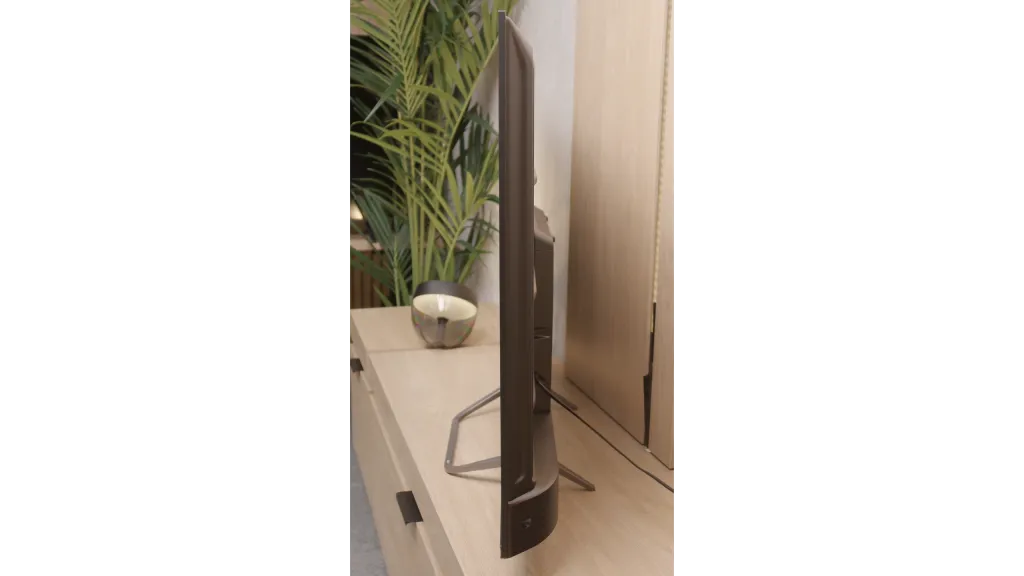
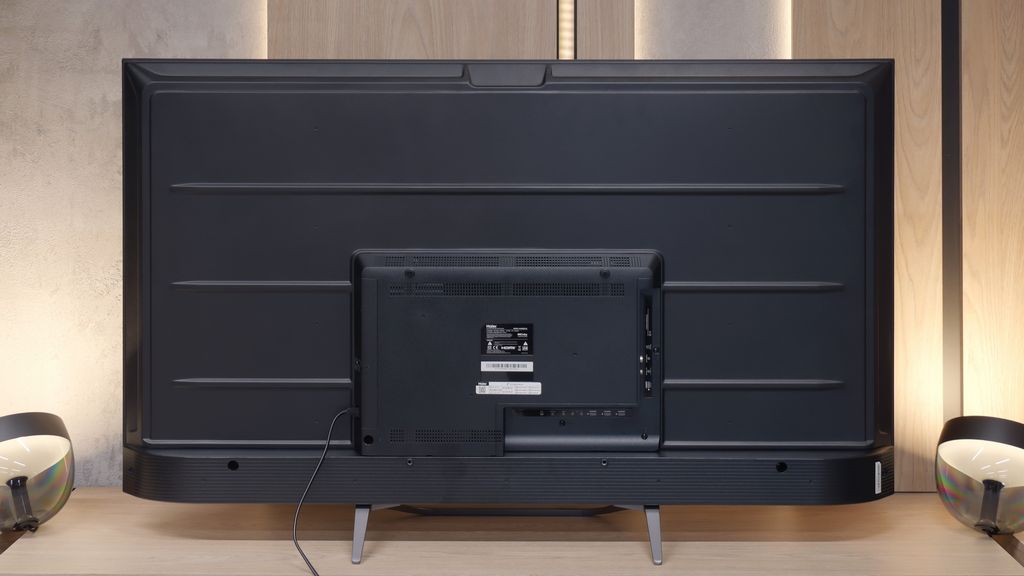
Contrast and black detail
5.6/10
6.3/10
Local dimming function: No
Local dimming function: No
Contrast:

Result
3,550:1

Result
5,200:1

Result
5,350:1

Result
5,400:1

Result
3,500:1

Result
5,200:1

Result
7,400:1

Result
7,550:1

Result
7,300:1

Result
6,450:1
Halo effect and black detail visibility:

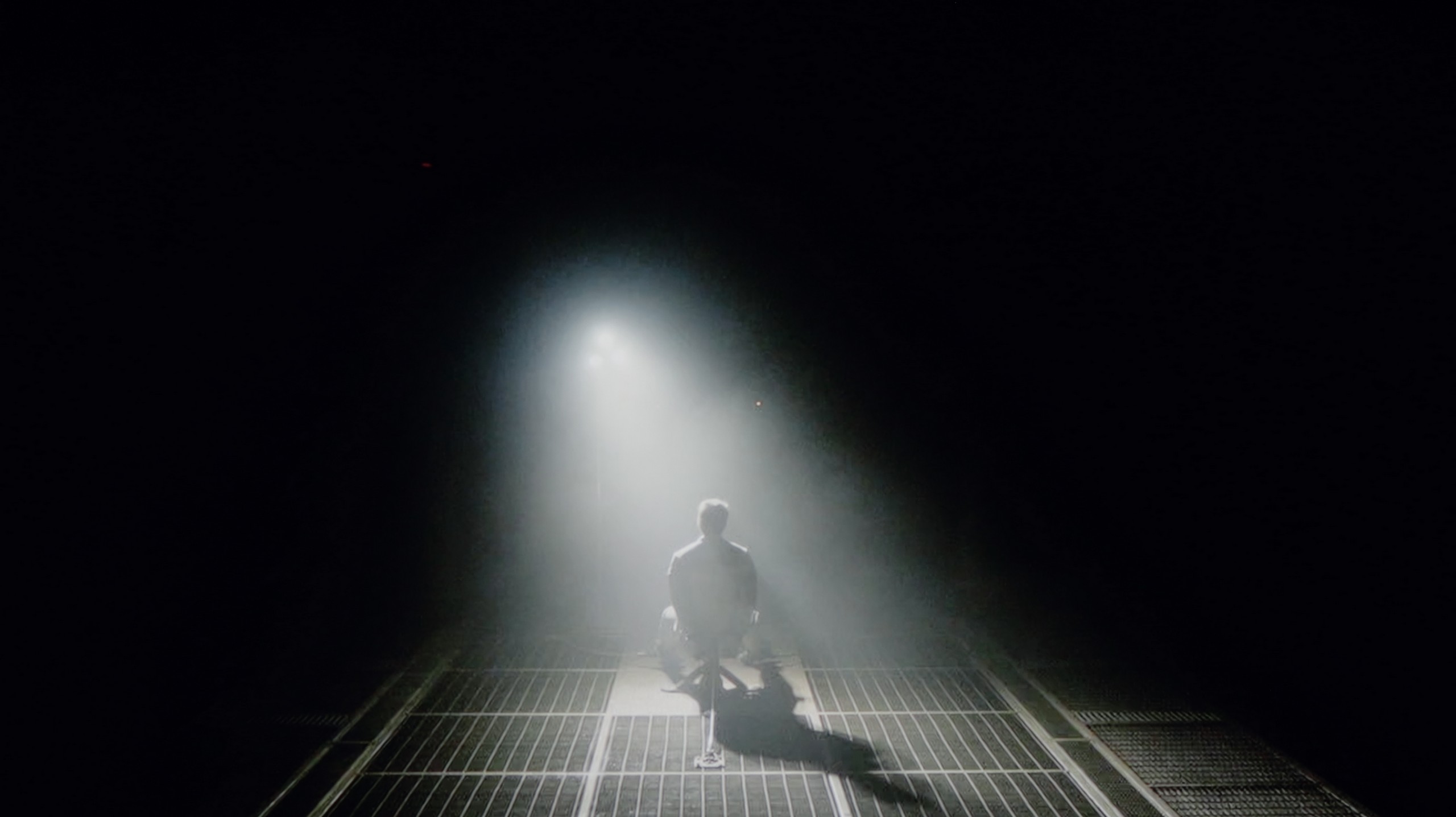
Alright, but let's get to the meat of it, that is, how the Haier K85F handles black and contrast. The key information is that the television uses a VA panel, which is crucial for image quality in dark scenes. Thanks to this, the contrast is really solid – our measurements indicated values around 5000:1, which is much better than popular IPS panels.
However, it is important to remember that we're discussing budget equipment. So, we shouldn't expect any advanced technologies like local dimming. The backlighting operates across the entire screen surface at all times. How did it look during viewing? We took the film "Oblivion" with its cosmic landscapes for a test, and we also checked classic black bars in other productions. The effect was quite decent. The black had good depth, but it wasn't perfectly inky – a slight blue glow could be noticed, indicating that the panel's backlighting was still active.
I must admit that approaching a TV in this price range, one instinctively crosses their fingers, hoping that at least the black won't be a grey blotch. Meanwhile, the Haier Q80FUX, specifically the 55-inch unit we have in our office, can pleasantly surprise in this regard. Its secret lies in the use of a VA panel, which tends to generate high contrast by nature. And these are not empty promises. During screenings, in the majority of film scenes, the contrast reported itself at levels ranging from 5000:1 with commendable regularity, often reaching as high as 8000:1. These are really strong results, considering the fact that this TV has no, not even minimal, form of local dimming. Translating this into couch-side experiences: for its price point, the Q80FUX offers solid black levels. Of course, it isn’t that perfectly velvety depth that makes the screen disappear into darkness. When we conduct a viewing in total light isolation, we can see that in the darkest parts of the image, the black betrays its budget origins, subtly shifting towards a bluish glow. However, this is a defect that is easy to mask – just a bit of light from a lamp in the corner of the room is enough for this nuance to become invisible, and the image regains a satisfying depth.
HDR effect quality
3.4/10
4.9/10
Luminance measurements in HDR:

Result
217 nit

Result
212 nit

Result
278 nit

Result
250 nit

Result
273 nit

Result
308 nit

Result
327 nit

Result
352 nit

Result
330 nit

Result
344 nit
Scene from the movie “Pan” (about 2800 nits)


Scene from the movie “Billy Lynn” (about 1100 nits)


Static HDR10


HDR luminance chart:
Haier Q80FUX
HDR luminance
Haier K85F
HDR luminance
Let’s now move on to one of the hottest topics in the world of televisions, which is the quality of HDR performance. In the case of the Haier K85F model, we unfortunately have to make it clear: if you’re looking for equipment to watch content in a wide dynamic range, you should steer clear of this model. The main issue is its very low peak brightness, which during our tests barely reached 250 nits. To give you a better idea of what that means – this level is fine for watching standard SDR content, but it’s absolutely insufficient to show any real benefits of HDR. The image simply doesn’t have the "power" to generate bright, striking highlights. All of our measurements and tests on specialised test patterns confirmed this. As if that wasn’t enough, the television also struggles with colour reproduction. In this budget build, there are no technologies that broaden the colour gamut, such as quantum dot layers (marketed as "QLED"). As a result, the coverage of the DCI-P3 colour space, which is crucial for HDR content, is only around 80%. In practice, this means that the image will not only be dark but also devoid of the vibrant, saturated colours that the director wanted to show us.
Alright, let's move on to the topic that really sparks discussions, which is the capabilities of the TV in HDR mode. Let's be clear from the start: the Haier Q80FUX is certainly not a brightness demon. The panel of this set can generate about 350 nits at peak, which in today's reality is an absolute minimum to even talk about the presence of HDR expanded dynamic range. On the plus side, this brightness is at least stable – regardless of the test pattern or film scene we used, measurements consistently hovered around 300-350 nits. These are at best adequate results, definitely far from the dazzling display of capabilities that we know from more expensive models. Fortunately, there is one aspect where the Q80FUX makes up for these shortcomings and does so considerably. We are talking about a QLED TV (or more precisely PFS LED), which means that thanks to the quantum dot filter used on the panel, it can generate truly juicy, vibrant colours. These are not empty promises – covering nearly 95% of the DCI-P3 colour gamut is an impressive result and directly translates into very pleasant, saturated colours for the eye.
Factory color reproduction
3.8/10
4/10


Factory Mode
After calibration
Alright, how does the television handle colours straight out of the box, without any intervention from our side? The Haier K85F offers a whole range of picture modes, such as Dynamic or Eco, but for anyone wanting to watch films according to the creators' intentions, there's essentially only one that matters: Film mode. This is where we focused our tests, and unfortunately, its name has little to do with reality. The picture on factory settings is very far from what we could call cinematic fidelity and requires many adjustments. Let's start with the white balance, which has a clear deficiency of red colour. In practice, this means the entire image has a cool, bluish tint. Even worse is the issue of brightness management, that is, the gamma curves (for SDR) and EOTF (for HDR). Their graph resembles a true rollercoaster, which terribly impacts the viewing experience. This results in unnatural dimming of SDR content, causing details in the shadows to be lost, and in the case of HDR – an excessive brightening that further exacerbates the problem of clipping. Such a combination, which consists of too cool white combined with chaotic brightness and too much blue colour saturation, leads to enormous errors in colour reproduction. Our measurements on a specialist ColourChecker chart showed errors (Delta E) regularly reaching and exceeding values of 8-9. To put it simply: errors above the threshold of 3 are easily noticeable to the naked eye, so such a result means that the colours on the screen are simply heavily distorted.
Factory settings for movie mode are seldom perfect, but in the case of the Q80FUX, we encountered a noticeable imbalance. In SDR content, the image was definitely too warm, due to an excessive amount of red in the white balance, giving the overall picture a slight sepia tone. Conversely, in HDR materials, the television fell into the other extreme – an excess of blue caused an unnatural, cool effect in perception. However, it wasn't the fickle white balance that was the biggest issue with this TV. The real culprit, responsible for the previously described problems, was hiding deeper. It turned out that the Q80FUX has completely miscalibrated gamma values and, crucial for HDR, a poorly executed EOTF curve. It was these erroneous factory settings that caused the notorious clipping of the brightest parts of the image, imposing that characteristic milky filter over them. Thus, we found the source of the problem. This situation led to general, significant colour inaccuracies that were easy to catch even for an untrained eye. Like every television we tested, we decided to calibrate this model as well, and you can find the results of these adjustments in the next paragraph.
Color reproduction after calibration
6.2/10
6.1/10
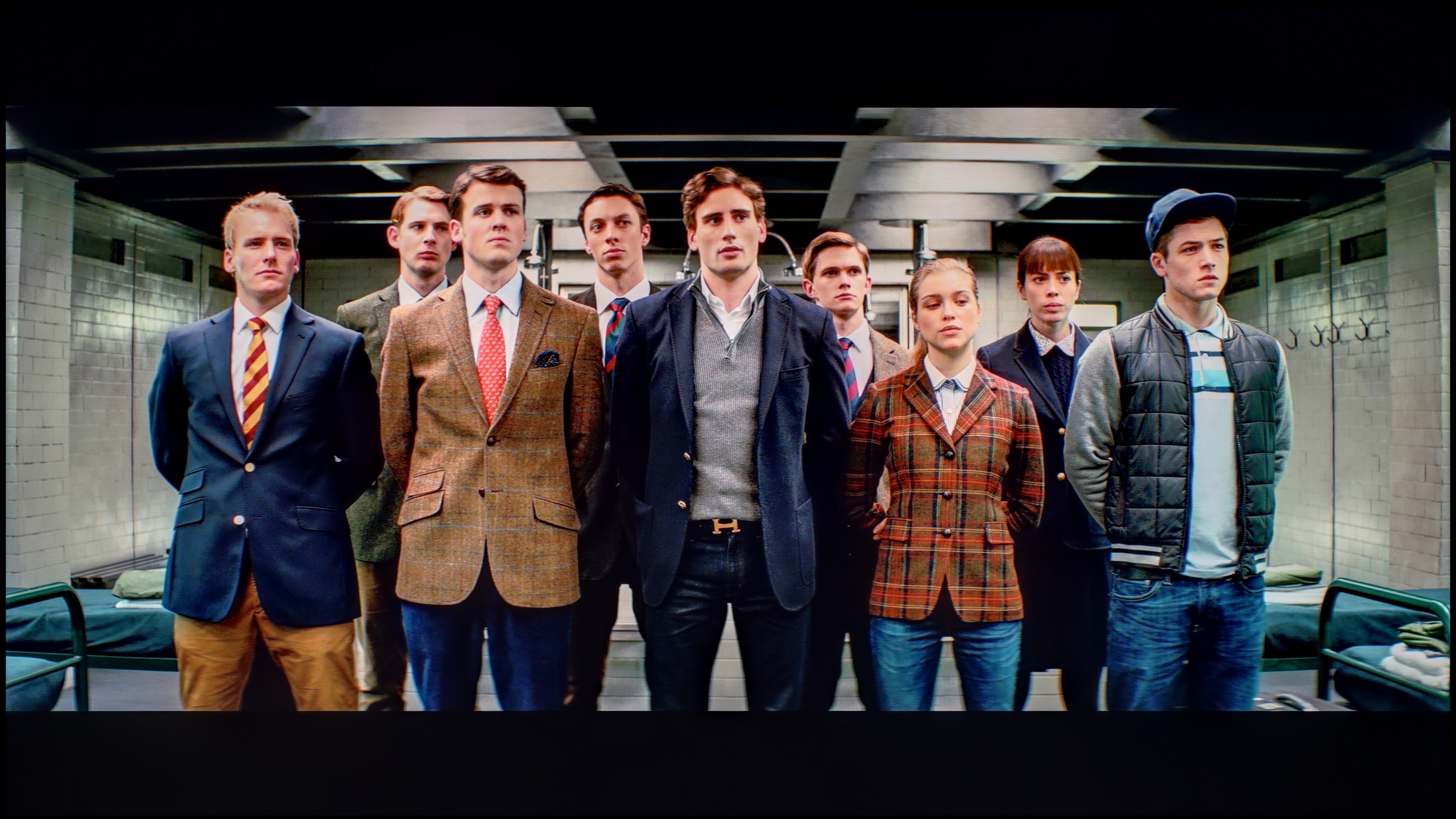
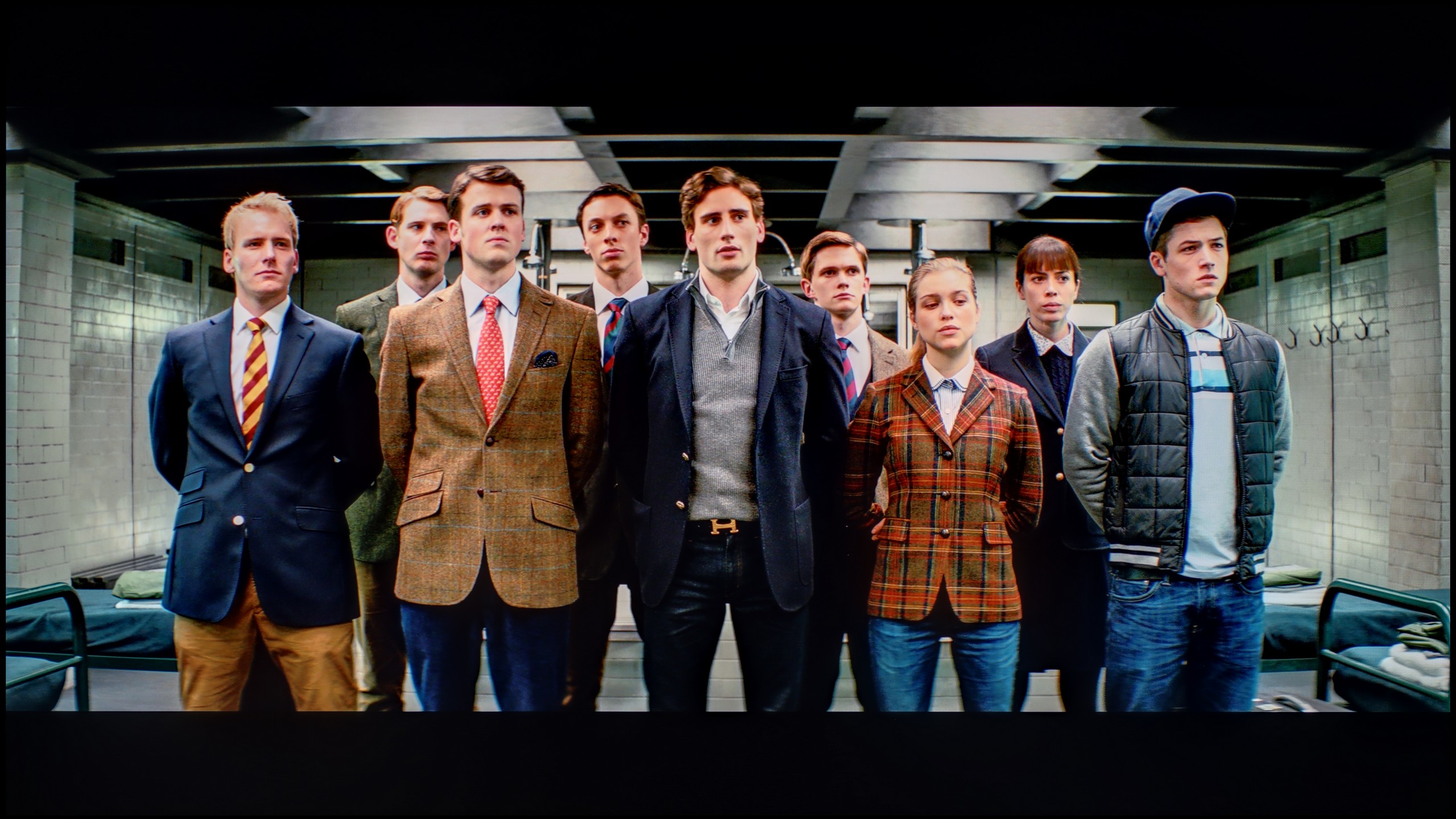


No good, but can anything be done about this picture? Is professional calibration able to save the situation? The answer is both yes and no. It needs to be said clearly that there are certain things we cannot overcome. The limitations of the construction itself, namely a poor panel and its narrow colour coverage, mean that you can forget about a sensible HDR effect – we won't be pulling the wool over your eyes on that. The biggest beneficiary of our adjustments is undoubtedly the SDR mode, and it is for watching such content, after calibration, that this television starts to make sense. We managed to tame the white balance in our own way. Although the television only offers basic, 2-point adjustment (rather than precise, 20-point), it's not perfect, but we successfully eliminated that unpleasant, cold "chill" in the picture. Above all, though, we noted a huge improvement in brightness management. The gamma curve, which previously resembled a rollercoaster, looks like an almost perfectly straight line after calibration. This is a sign that the television can finally display an image without artificially dimming or brightening it. The conclusion is simple: even with such a cheap television, professional setting correction can achieve a great deal and extract the maximum potential from it.
The results of our calibration procedures must, unfortunately, be regarded as twofold. Generally speaking, the picture is undeniably better than before the adjustments; however, the biggest winner of this process has been SDR content. It is precisely here, after correcting the gamma curves and white balance, that we achieved results that can safely be called very good. Once set up, the Q80FUX truly shines in standard dynamic range, displaying only slight errors in the most challenging skin tones. Unfortunately, the weakest link remains HDR content. And here's the paradox: even though we managed to calibrate the white balance to near perfection, the overall colour errors still remain at quite a high level. The reason is that the television still interprets the static HDR10 metadata "in its own way," stubbornly enforcing that unfortunate image clipping effect, which inevitably leads to significant distortions. Although we successfully eliminated the factory excess of blue, due to this electronic interference, the screen can still veer into somewhat too cool tones. That’s just how this television is.
Smoothness of tonal transitions
7.6/10
7.5/10












It's time to address an issue that is often overlooked by many but can be quite irritating to the discerning (and not just discerning) eye. We're talking about the smoothness of tonal transitions, or how seamlessly the screen displays transitions between very similar shades of one colour – for instance, on a clear blue sky. We have to admit that in this category, the Haier K85F, considering its price, performs quite decently. In bright scenes, such as the aforementioned sky or expansive landscapes in the film "The Martian," there are no stark, contrasting bands. Yes, if we scrutinise closely, we can spot minimal imperfections, but generally, the effect is more than satisfactory. However, the situation changes when darker scenes make an appearance on the screen, such as gloomy corridors in games or nighttime landscapes. Here, banding, or the effect of posterization, becomes much more evident. Transitions in shadows and greys are no longer as smooth and can become quite bothersome to a more sensitive eye. It's not a level that would completely disqualify the television, but it is clear that this is an area where costs were saved.
Analysing the ability of the television to handle subtle tonal transitions, or "banding", leads us to some interesting conclusions. The Haier Q80FUX seamlessly blends adjacent colours in most scenes, creating a smooth, cohesive image. However, this process is not without its flaws. During our tests, we noticed minor issues and imperfections in each of the test scenes we used. These may not be errors that aggressively jump out and ruin the viewing experience, yet their presence is worth noting. Interestingly, this receiver does not exhibit any particular weaknesses or strengths in this regard – it handles this challenge in exactly the same way, regardless of whether it is displaying delicate gradients of a bright sky or dark transitions in shadows.
Image scaling and smoothness of tonal transitions
4/10
4/10
Smooth transition function

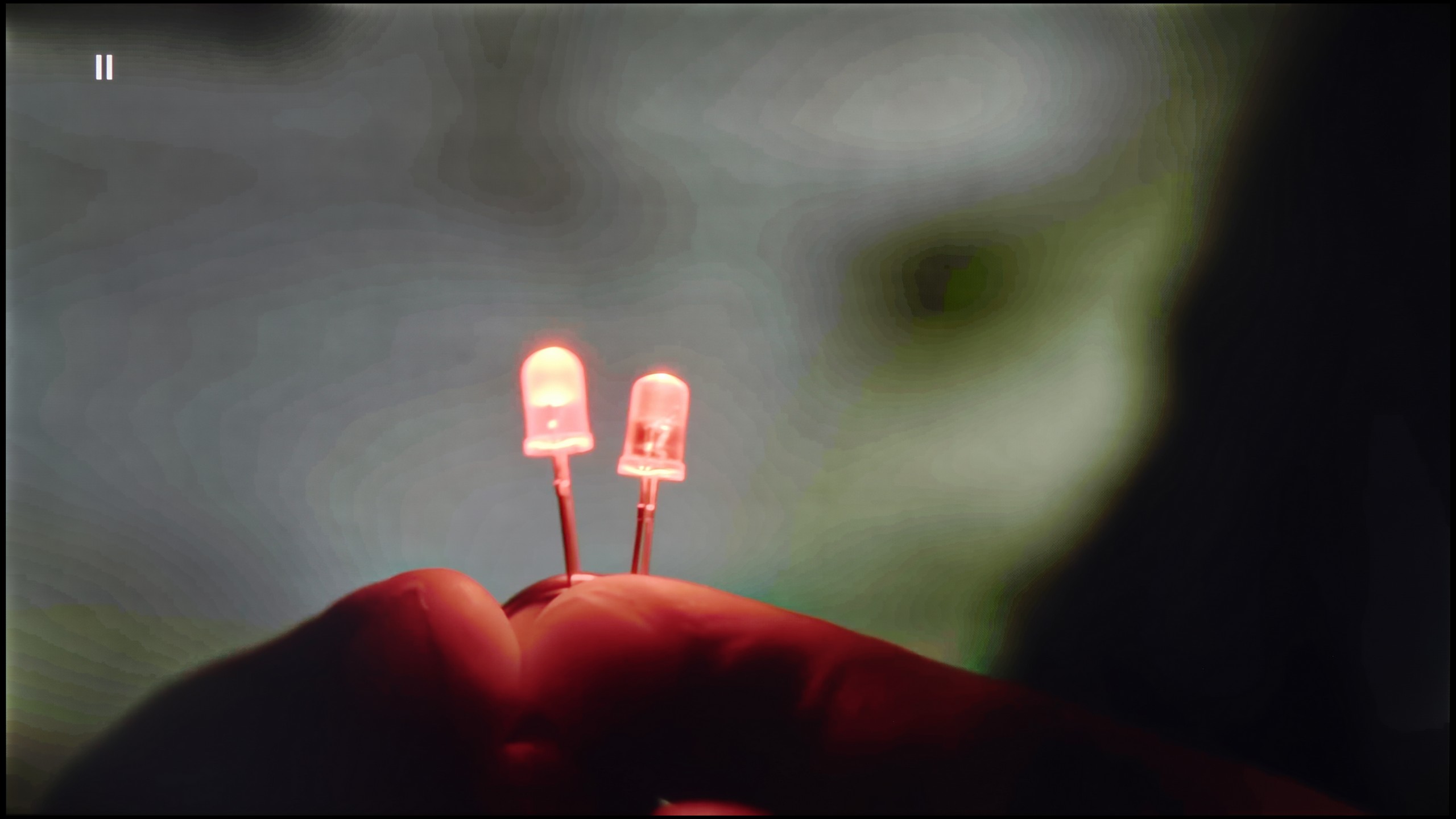
Image without overscan on the SD signal


Let’s move on to digital processing and image scaling, specifically how the Haier K85F handles lower resolution signals, such as from regular television. Right off the bat, we encounter an incredibly annoying and completely incomprehensible issue – the overscan is enabled by default. This means the television artificially enlarges the image, cutting off its edges on every source, even 1080p. To see the full frame, you have to dig into the screen settings each time and manually switch the format to "stretch to 16:9." It's a minor detail, but devilishly frustrating. The scaling of content to 4K resolution can be described in one word: acceptable. And that's about it. The image processor doesn't strip detail from the image, nor does it generate jagged edges or other artifacts. It simply does its job, without any bells and whistles. It’s alright, but nothing more. The most significant and noticeable shortcoming in the digital processing section is, however, the absence of a tone transition smoothing feature. This is an algorithm that could significantly reduce the annoying banding effect we mentioned earlier. Unfortunately, the manufacturer did not foresee such a solution, condemning us to watch the imperfections of the panel and low-quality material in all their glory.
If there's one area where Haier clearly shows it still has a lot to catch up on compared to the market leaders, it's digital image processing. The upscaling, well... it's just okay. And that's really all that can be said about it. It does what it's supposed to do: ensures that lower resolution signals don't scare you with harsh pixelation on the screen and don't look like a forcibly enlarged postage stamp. However, it's far from the finesse and "intelligent" sharpening that more experienced players in this market have developed over the years. The biggest issue with the Q80FUX software is the almost complete lack of additional "cleaning" and smoothing features for the image. The receiver offers no noise reduction mechanisms or gradient enhancement. This means that with older or highly compressed materials, we simply have to accept that all the imperfections in tonal transitions or colour blending, which we mentioned earlier, will constantly accompany us during viewing.
Blur and motion smoothness
4.5/10
4.5/10
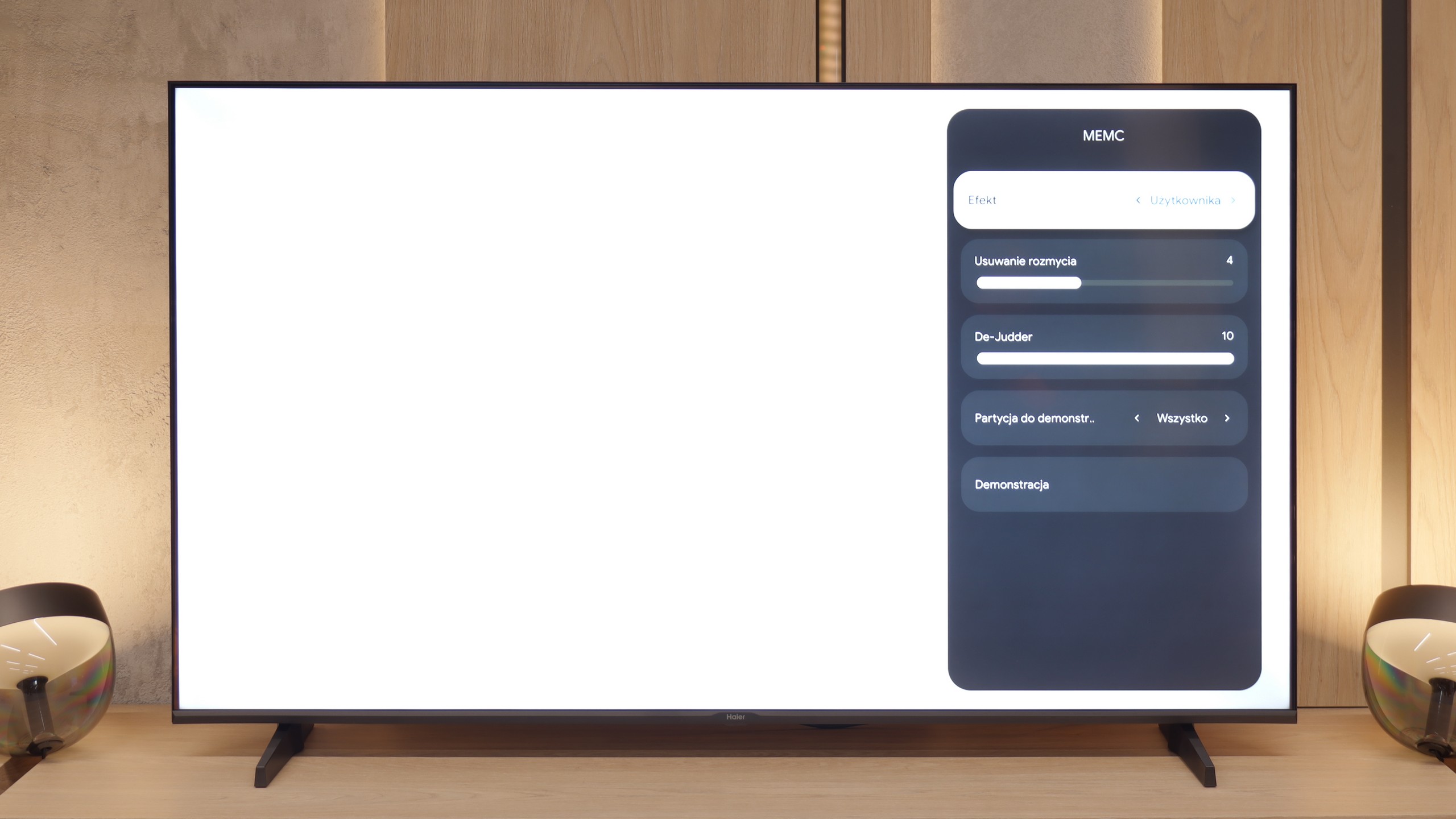
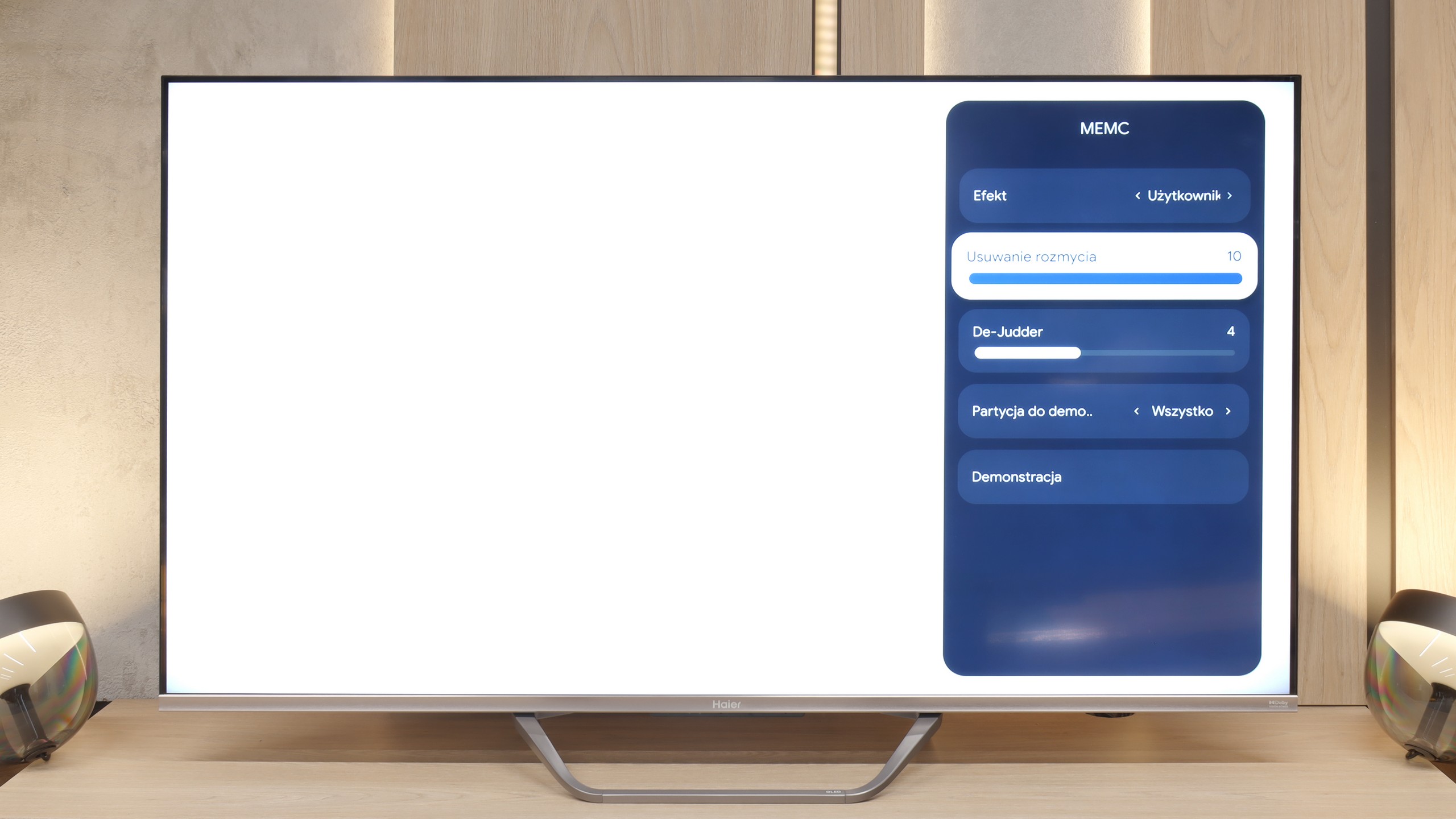
Blur (native resolution, maximum refresh rate):
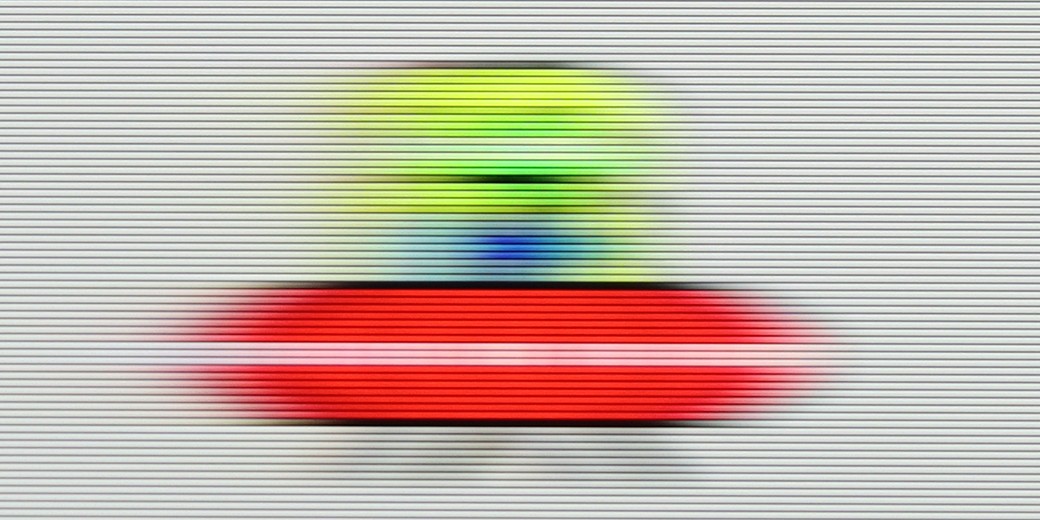
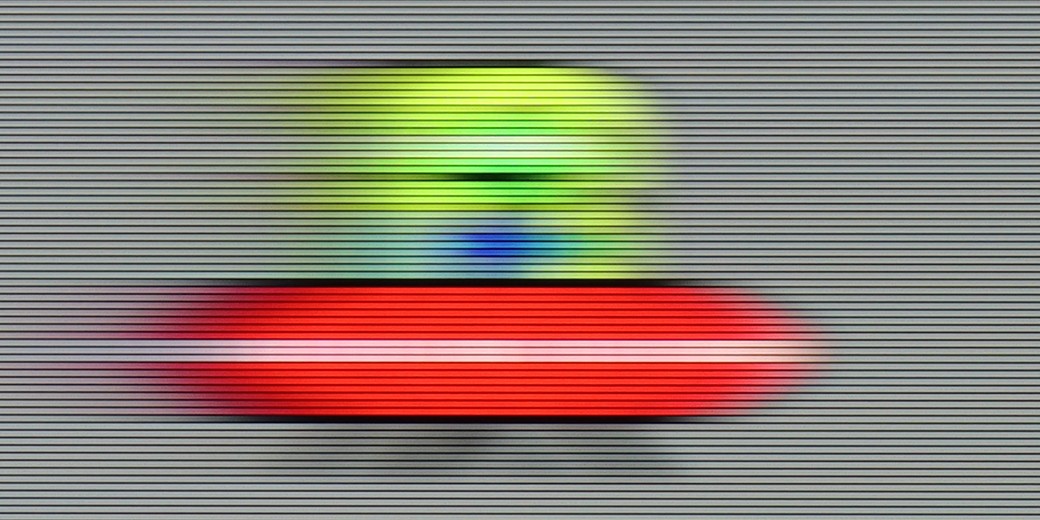
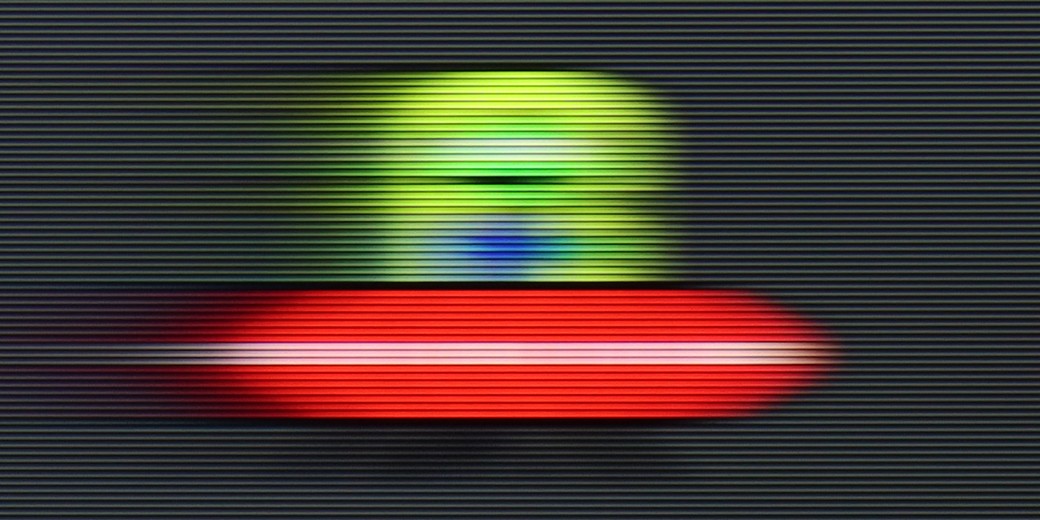
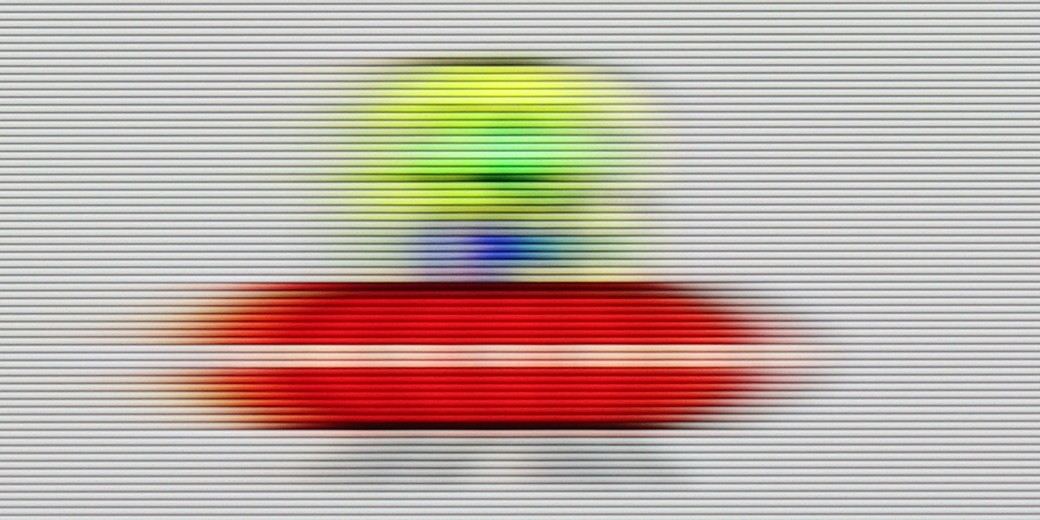
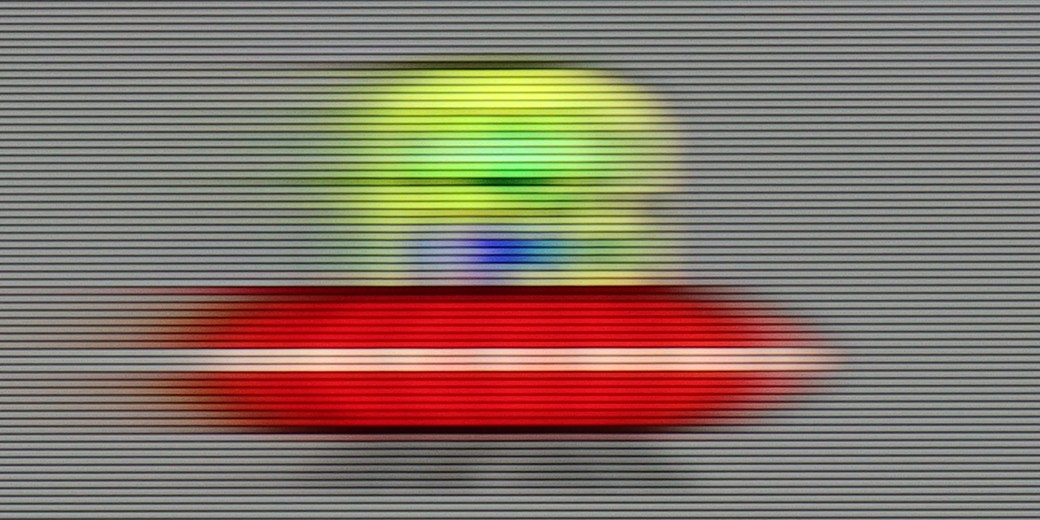
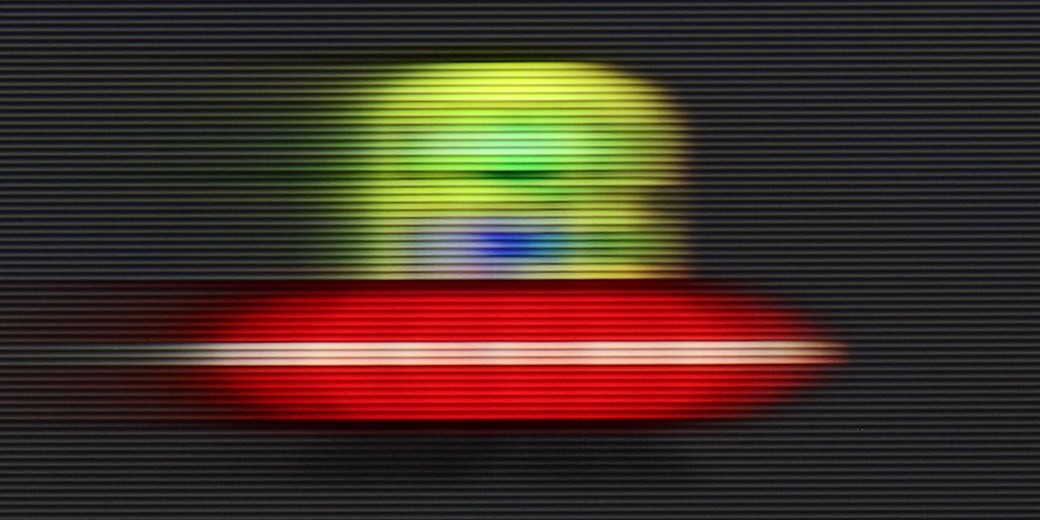
The panel in the K85F model operates at a native refresh rate of 60 Hz, which sets certain expectations for image smoothness right from the start. However, we must admit that we were very positively surprised when we found two separate motion control sliders in the settings menu: one labelled "Motion Blur Reduction" and the other "De-Judder." Such generosity in this price segment is an absolute rarity, as manufacturers usually offer at most one shared option. Unfortunately, our enthusiasm faded as quickly as it appeared. It soon became clear why Haier was so "generous" – the slider responsible for reducing motion blur is simply a decoy. Sliding it makes absolutely no visible difference on the screen, so only one of the two options works.
The issue of motion fluidity and blurring is largely predetermined by the use of a 60Hz panel, which naturally makes it difficult to recommend this receiver to enthusiasts of very dynamic content. Fortunately, in the Q80FUX, we find a few options (although, as will soon become clear, really just one) intended to enhance the experience with older film productions. There is a "De-Judder" slider available, which indeed affects motion fluidity and allows us to adjust it to our preferences: from raw, cinematic frame rates to a more theatrical, smoothed presentation. However, a true surprise awaits us right next to it in the menu. There is also a second slider, supposedly dedicated to removing blur – this is a feature we typically encounter in 120Hz panels, aimed at combating blurring in sports. As we expected, recalling memories from testing the K85F model, here too this slider is merely a façade. Its adjustment contributes absolutely nothing to the picture and simply seems to be an oversight by the product engineers who left a non-functional option in the software for this type of panel.
Console compatibility and gaming features
4/10
5.6/10
- ALLM
- VRR
- VRR range48 - 60Hz48 - 120Hz
- Dolby Vision Game Mode
Yes, high input lag
- Correct implementation of HGIG
- 1080p@120Hz
- 1440p@120Hz
- 4K@120Hz
- Game bar

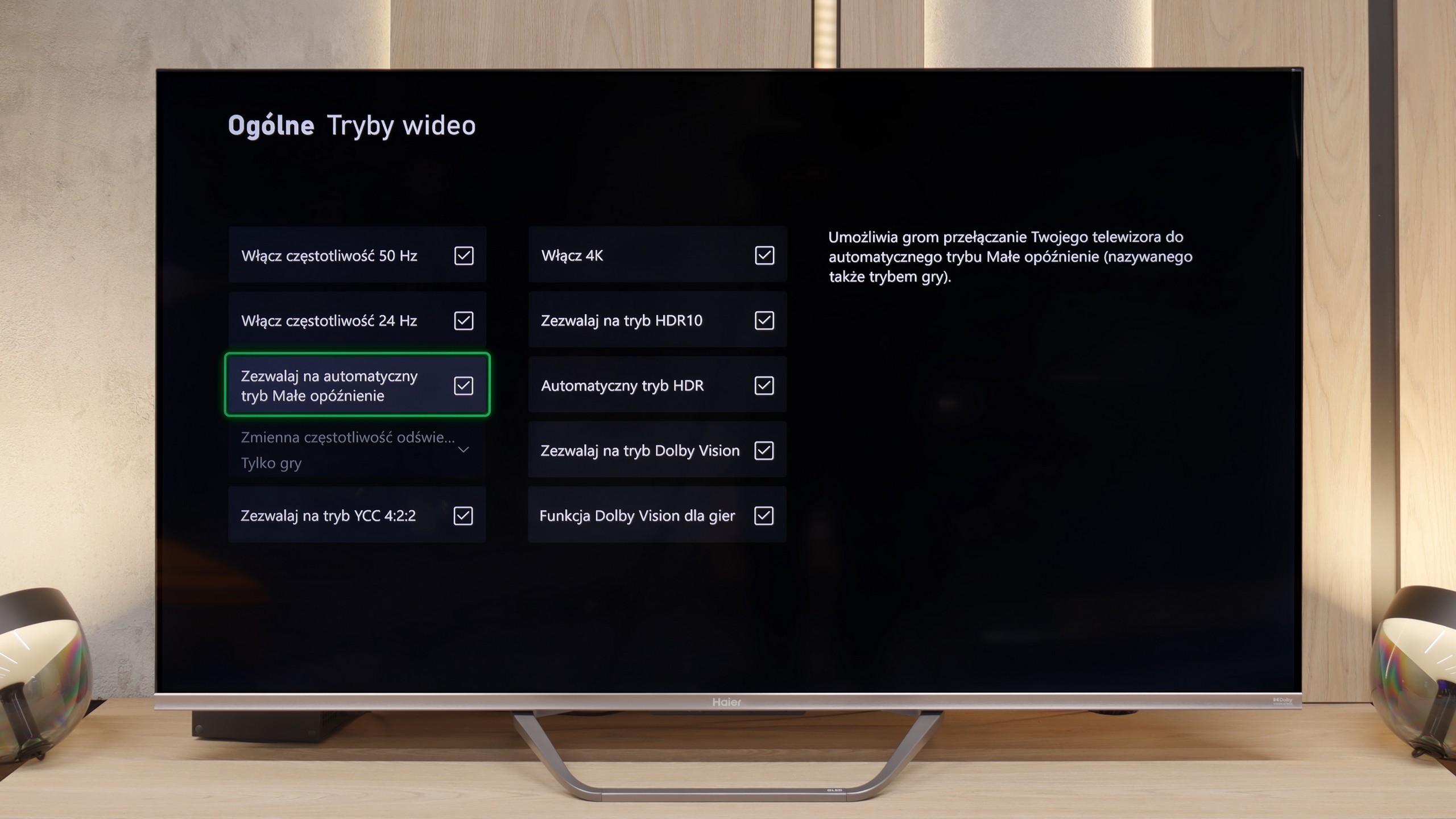
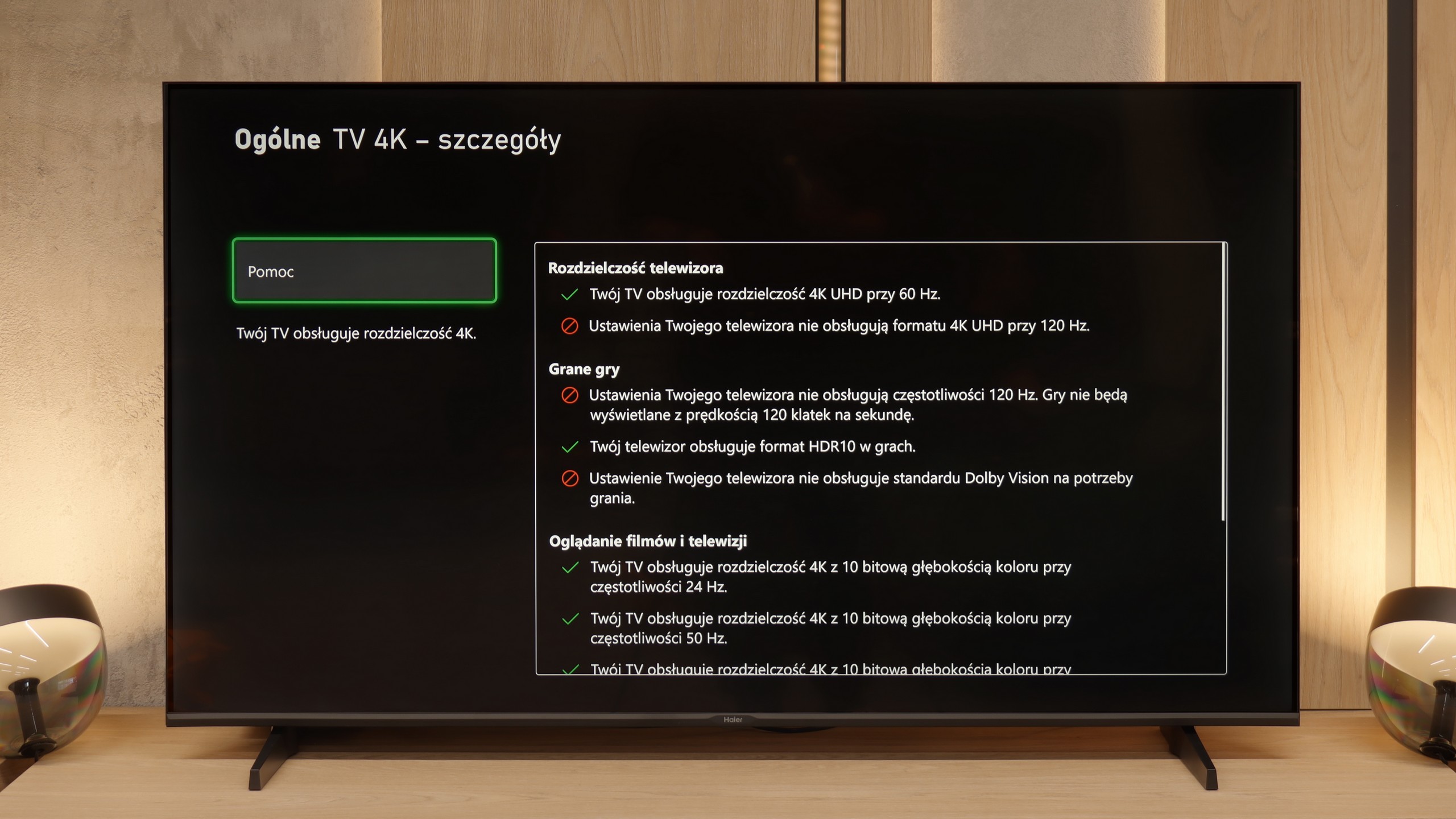
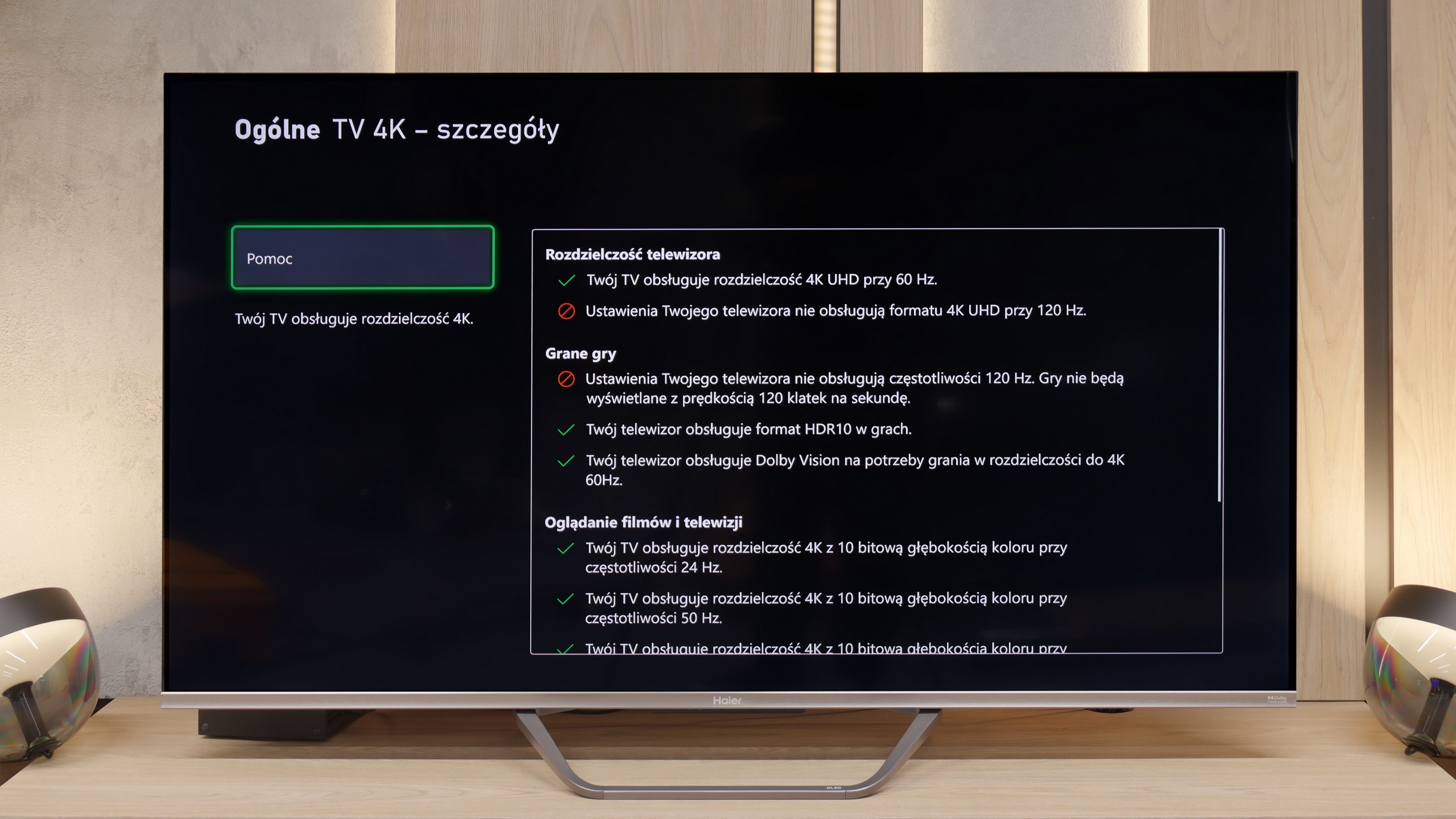
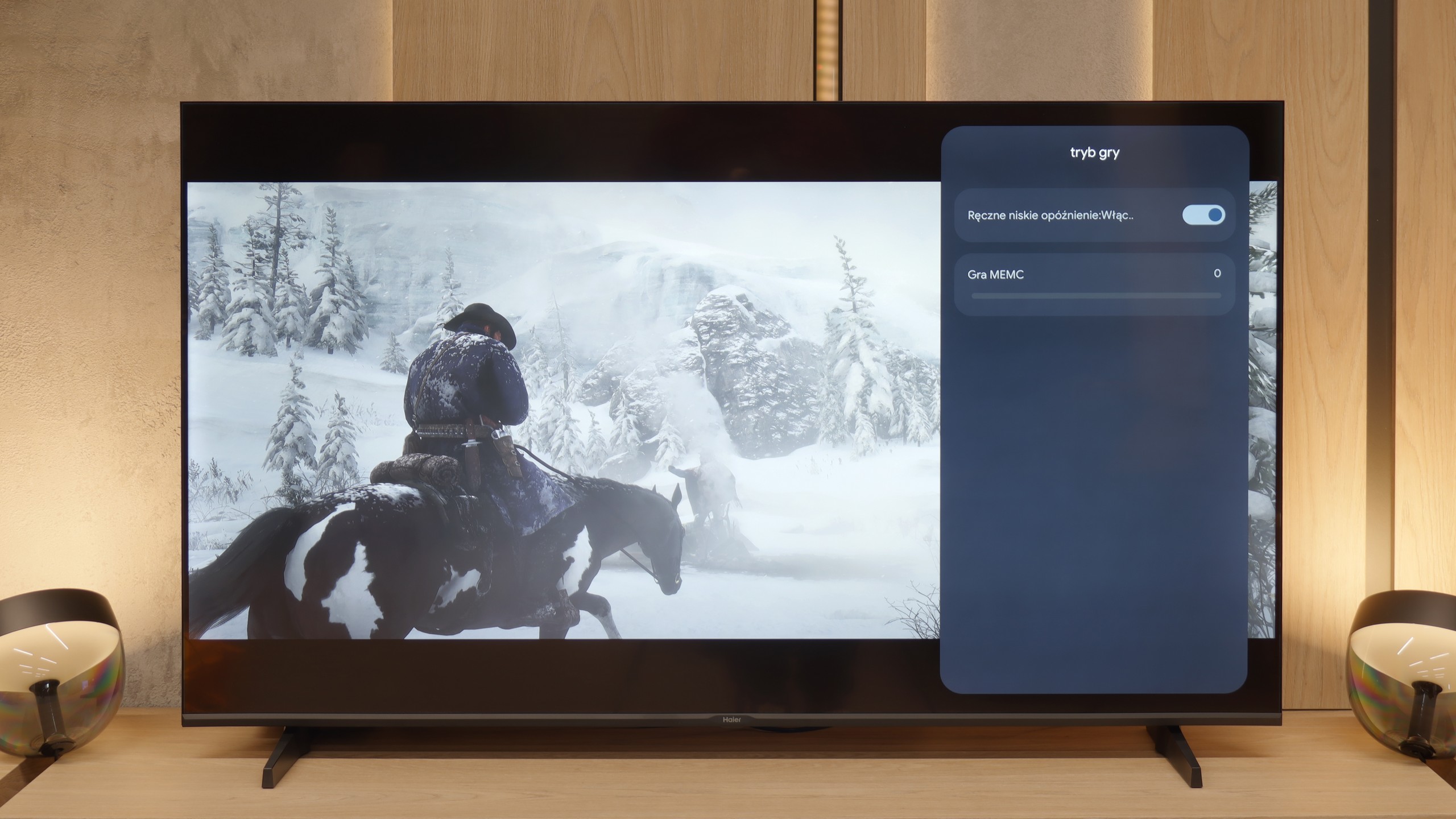



Let’s move on to the features for gamers, although we must point out straight away that this is more of a proposal for the "occasional" ones. The manufacturer does boast in the specifications about having HDMI 2.1 ports, which looks impressive on paper, but in reality, it’s largely a marketing ploy. What good is a modern port when the heart of the television is a panel with a refresh rate of 60 Hz? It physically cannot display a signal at 120 frames per second, even at lower resolutions, which takes away HDMI 2.1’s key advantage. What a shame. (That’s why in our tests we note this as HDMI 2.0 ports). Another odd issue is the TV's response to an attempt to calibrate HDR from the console. Changes to brightness settings result in very unnatural image behaviour, which could suggest incorrect implementation of the HGiG standard. To be honest, one shouldn’t worry too much about this, as we have repeatedly mentioned, we simply do not recommend using any HDR content on this screen. However, to counterbalance the negatives, the Haier K85F does have two big and unexpected advantages. The first is the presence of ALLM, or automatic game mode, which switches the TV to low latency mode as soon as it detects a connected console. The second, even bigger surprise, is support for VRR, or variable refresh rate. While it operates within a very modest range of 48-60 Hz, its mere presence is commendable. Thanks to this, the image in games can “tear” less, which realistically improves the gaming experience.
Entering the realm of gaming, the Haier Q80FUX proves to be quite a good companion for the "casual gamer." It is equipped with some highly sought-after features today such as VRR (variable refresh rate) and ALLM (automatic low latency mode). However, the biggest surprise is something else. Even though we don't have a 4K@120Hz panel here, the television can accept and display a 120Hz signal at a lower resolution (Full HD). This is a very useful feature, allowing you to consciously switch the console to a lower resolution mode in exchange for significantly higher fluidity, which is a perfectly acceptable compromise in the gaming world.
We won't particularly complain about the lack of additions like the "Game Bar," as it's just a nice extra. However, the most concerning issues arise when we enter the world of HDR in gaming. Due to the fact that the television continuously adapts the signal "in its own way," setting the brightness on the console according to the HGIG standard is almost impossible to accomplish according to the instructions. Worse still, in Dolby Vision mode for gaming, the input lag increases to around 50 ms, which is a high enough value that essentially makes this mode unusable. Generally speaking, we still wouldn't recommend gaming on this television in HDR mode, so these aren't that serious shortcomings. What’s most pleasing is the presence of 120Hz in Full HD, making the Q80FUX quite a cool television for the occasional gamer.
Input lag
10/10
9.4/10
SDR
HDR
Dolby Vision
We must give credit where it's due – there is one parameter where this television absolutely shines and puts to shame many more expensive models. We're talking about input lag, or signal delay. Our measurements showed a remarkably low result of just 13 ms. This is a huge plus that makes gaming control lightning-fast and incredibly responsive. In this regard, the K85F performs excellently.
If there is one category in which the Haier Q80FUX absolutely shines and shows its claws, it is input lag. In this respect, the TV presents downright outstanding results. In 120Hz mode (achieved, let's remember, at a lower resolution), input lag drops below 10 ms, which is an excellent value, worthy of top gaming monitors. Only slightly worse, but still at a very good level, is the classic 60Hz mode – here, measurements consistently indicated around 12-14 ms. These are results that much more expensive, dedicated gaming constructions would not be ashamed of. The only, but significant, stumbling block is the Dolby Vision mode. As we established earlier, its activation raises input lag to an unacceptable level, so we definitely advise against using it during any interactive gameplay.
Compatibility with PC
6/10
6/10
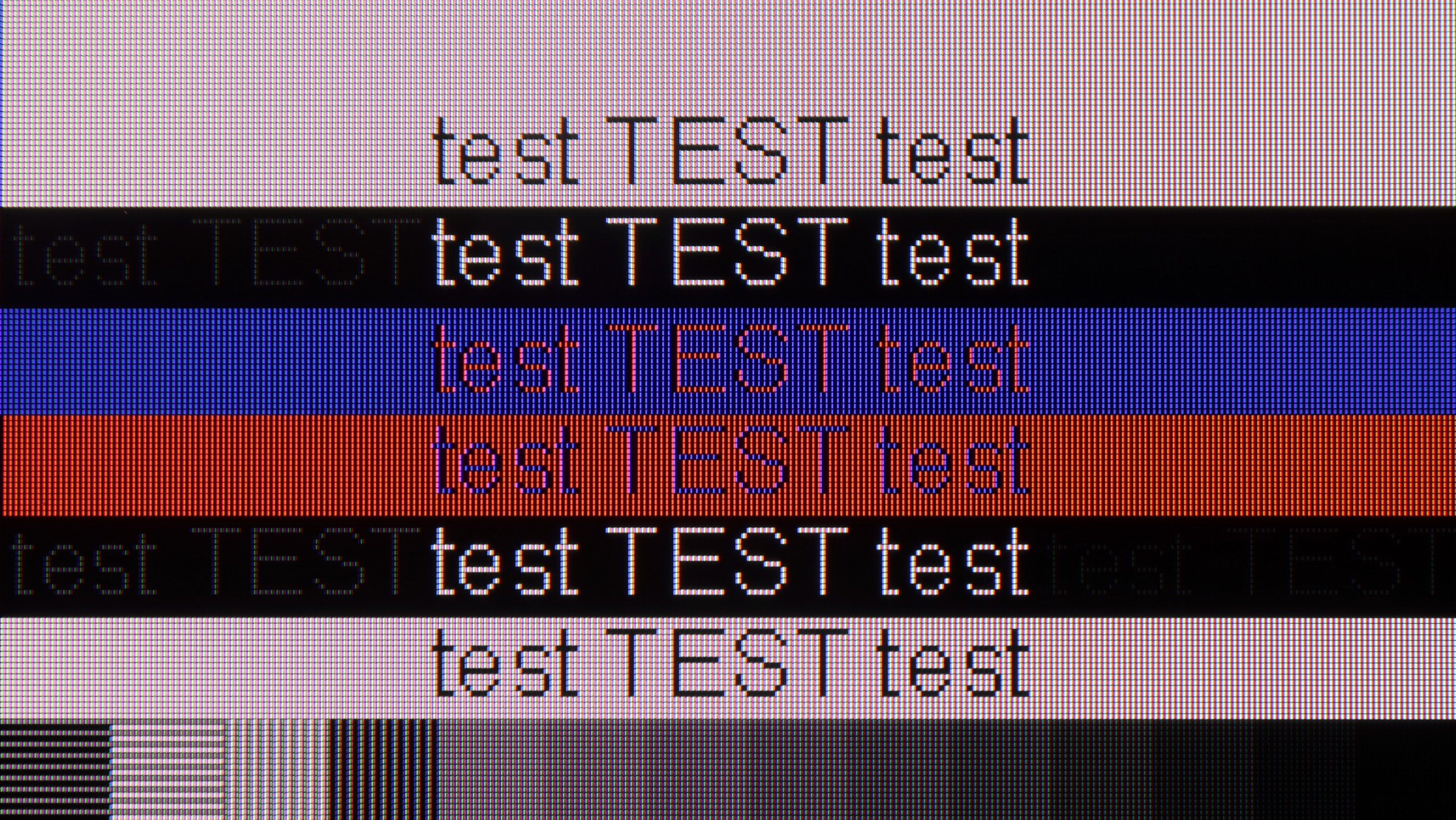

And what if we tried using this Haier as a computer monitor? Here, what was a big surprise for us was that the television performs exceptionally well. For office work, it’s perfect. All thanks to the fact that it correctly handles the so-called 4:4:4 chroma sampling. To put it simply: every little letter on the screen is sharp, without annoying coloured edges or blurriness. Sure, let’s be frank – this is not equipment for PC gamers. 60 Hz is too low for them. But if you just need a big screen for text work, browsing the internet, coding or displaying presentations, the K85F excels in this role. This is one of its strongest and, let’s face it, most unexpected applications.
We also checked how the Q80FUX performs when connected to a computer. Here again, we were pleasantly surprised – it handles this really well. The most important thing is that the fonts are very readable, so nothing blurs and you can work normally on it. Additionally, just like with consoles: we can set a lower resolution here to achieve a high refresh rate of 120Hz in return. What’s crucial is that in this mode, G-Sync started correctly and functioned well. This just confirms that this television is truly a successful and efficient piece of gear for gaming, also on a PC.
Viewing angles
2.8/10
3.3/10
At nearly the very end of the evaluation of the panel itself, we left out the viewing angles, which unfortunately are one of its biggest weaknesses. It must be honestly admitted that this is not surprising – it is simply a natural and commonly known feature of VA-type panels. In the unit we tested, interestingly, the brightness of the image did not drop drastically when we moved away from the centre of the screen. However, the real problem lies with the colours, which instantly begin to fade. A slight change in position on the couch is enough for the hues to lose their saturation and become washed out. In this regard, the Haier K85F presents a very average, typical level for this technology.
Anyone planning screenings with a wide family group must be aware of the fundamental compromise that Haier has decided upon by implementing a VA panel in this model. This technology has indeed provided us with deep blacks and high contrast, but an inherent characteristic is also a noticeable narrowing of viewing angles. It’s enough to sit a bit further to the side of the couch to immediately notice how the colours start to lose saturation and the image fades. It’s simply a classic trade-off – we gain something (contrast) at the expense of something else (angles) – and the Q80FUX fits perfectly into this scheme.
Daytime performance
4.1/10
4.8/10
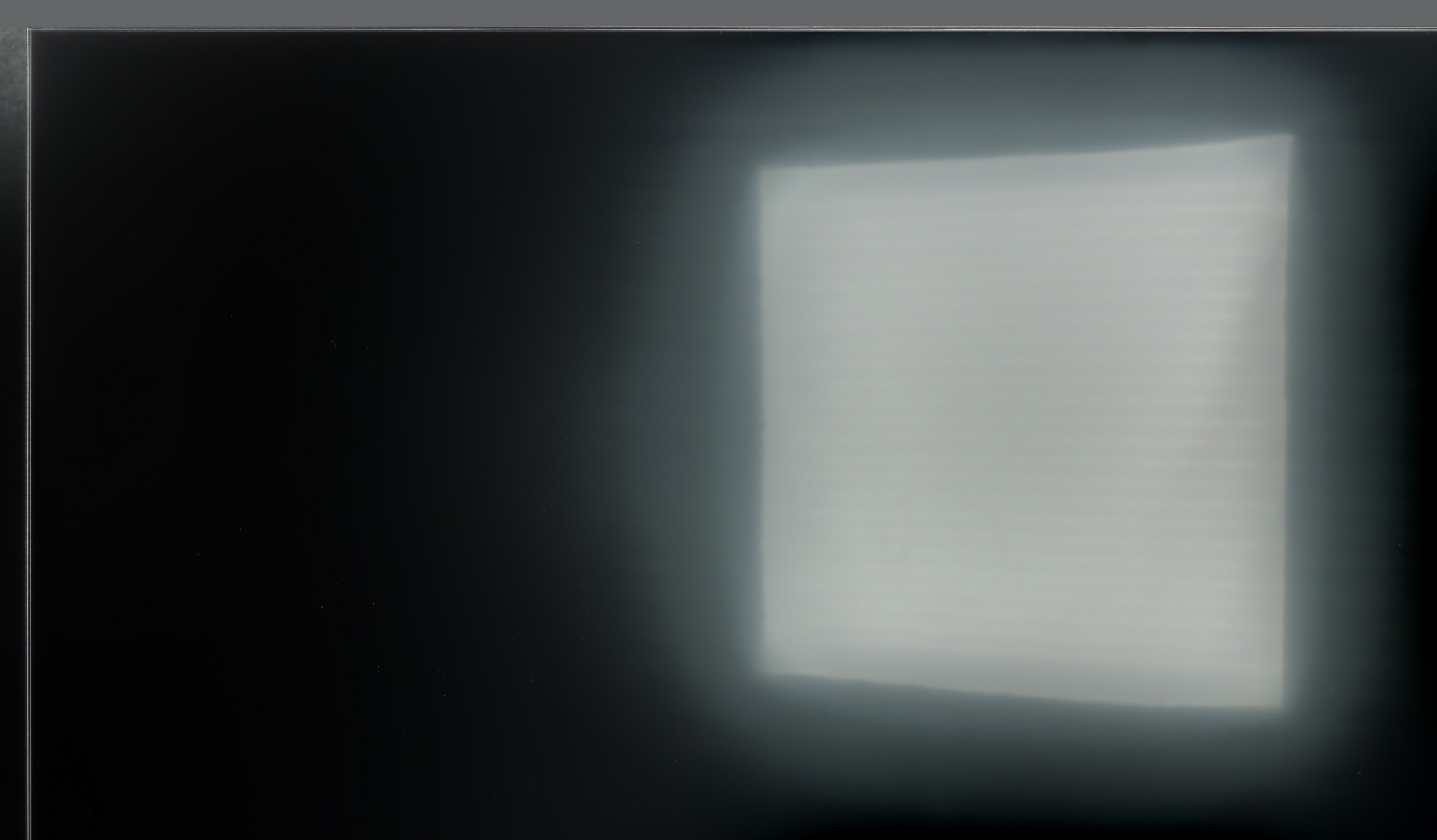
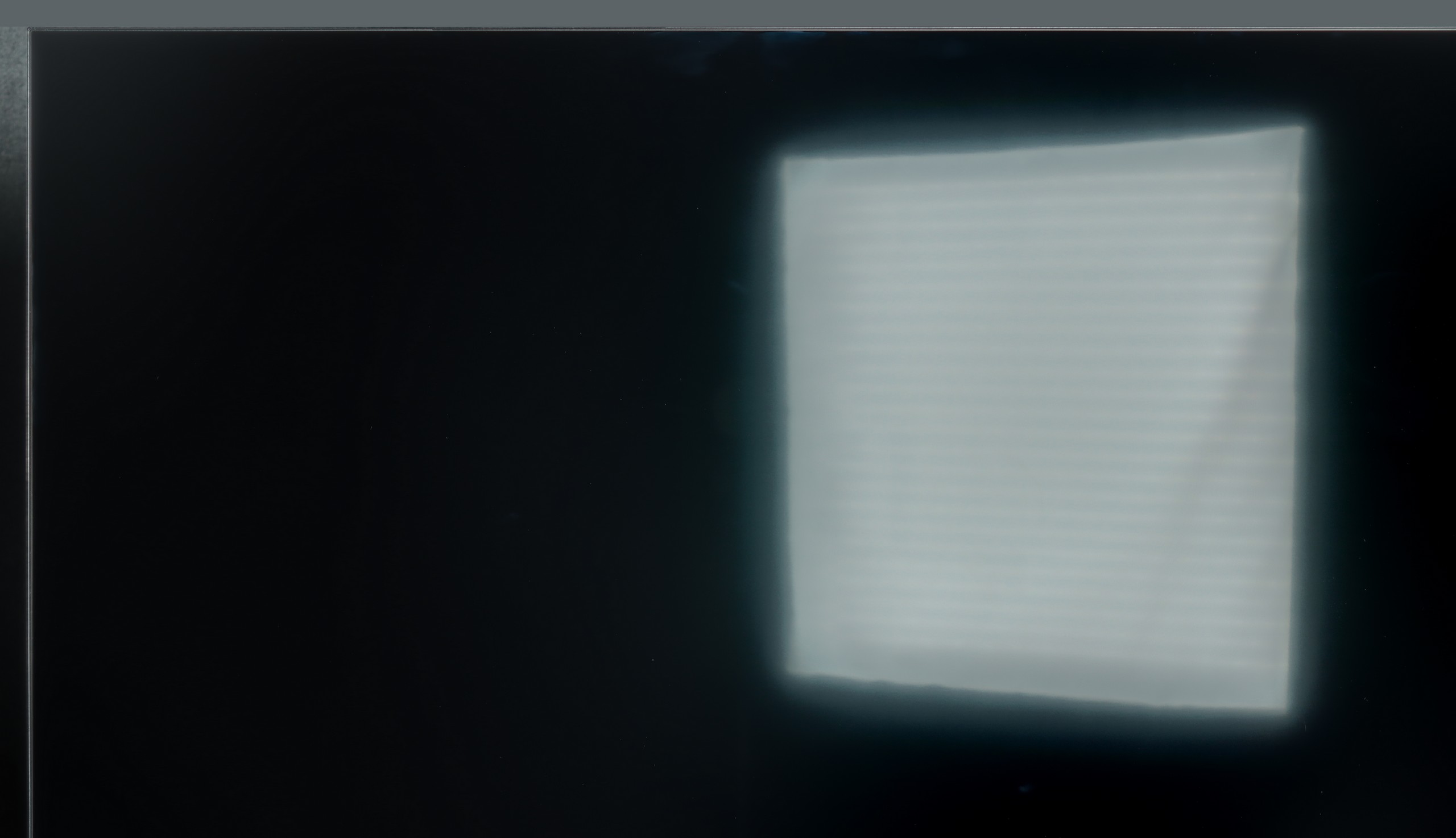


Panel brightness
Average luminance SDR
Haier Q80FUX: 317 cd/m2
Haier K85F: 276 cd/m2
And how does the television perform in confrontation with daylight, for example in a brightly lit living room? Unfortunately, we don't have good news here. As we have established, it is a television with relatively low brightness, which becomes a serious drawback when faced with sunlight. The situation is further worsened by the screen coating used. Instead of effectively suppressing reflections, its satin structure tends to unfavourably scatter them. In practice, this means that the reflection of a window or lamp turns into a large, blurred, milky haze that degrades contrast and effectively hinders viewing. The conclusion is therefore clear: if the television is to be placed in a bright room, the K85F model will not be a good choice.
The receiver's clash with the daily challenges posed by a bright lounge is quite decent with the Q80FUX, although it's certainly hard to talk about perfection here. The panel itself is equipped with a coating that effectively manages to suppress most reflections and glare from the surroundings. Equally important, even in more challenging lighting conditions, the screen can maintain pleasantly saturated colours. However, the weakness of this construction is revealed when backlight brightness comes into play. The previously mentioned, rather moderate maximum brightness (around 350 nits) means that in confrontation with intense natural light coming through the window, the screen often struggles to "break through." On a sunny day, the image might simply lack the necessary expressive strength.
Panel details
Subpixel Structure:
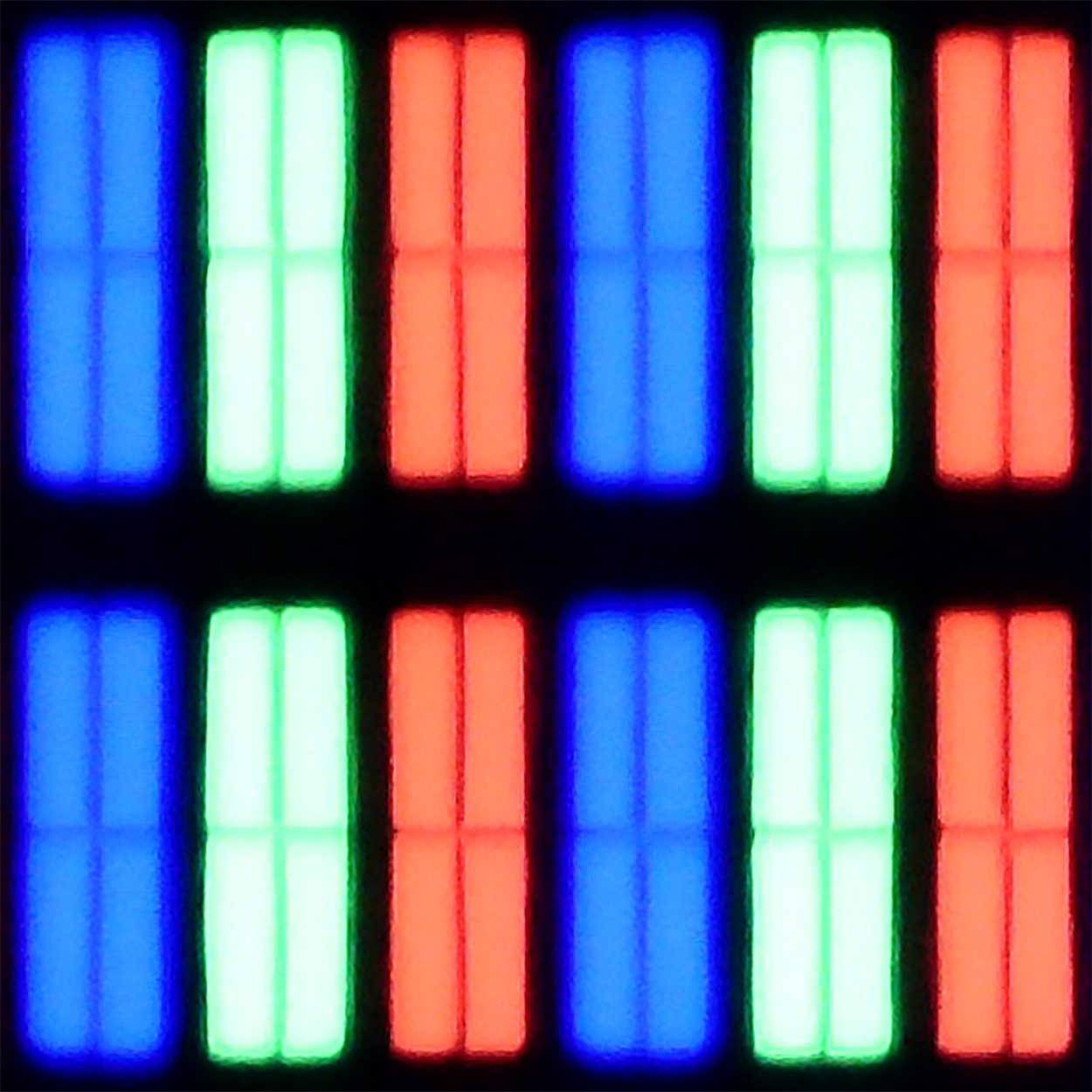
Panel uniformity and thermal imaging:
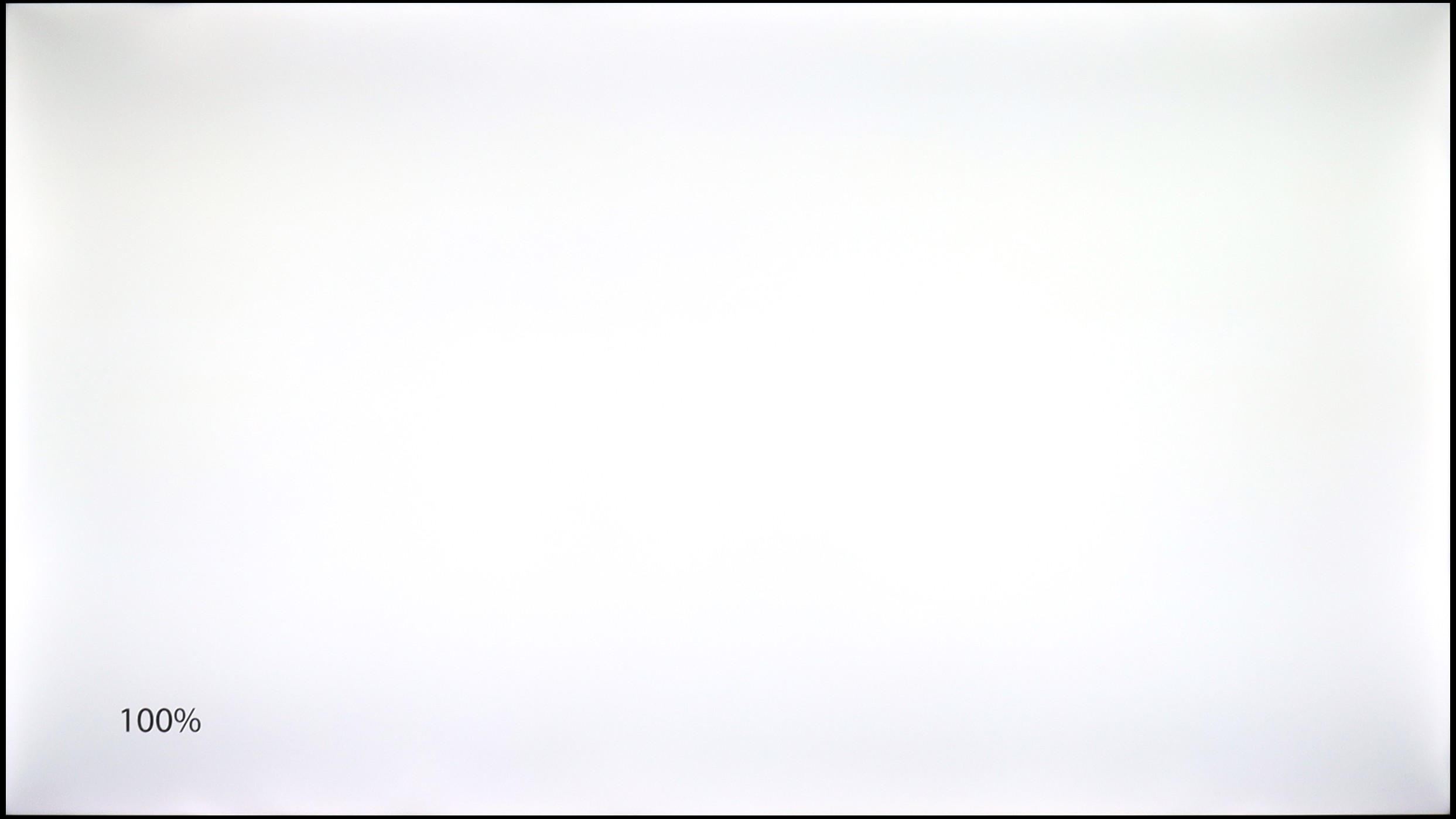

Haier K85F
Haier Q80FUX
TV features
5.5/10
5.6/10
- HDMI inputs4 x HDMI 2.0, 0 x HDMI 2.14 x HDMI 2.0, 0 x HDMI 2.1
- Other inputsRCA (Chinch)RCA (Chinch)
- OutputsToslink (Optical audio), eARC (HDMI), ARC (HDMI), Mini-Jack (Headphones)Toslink (Optical audio), eARC (HDMI), ARC (HDMI), Mini-Jack (Headphones)
- Network InterfacesWi-Fi 2.4GHz, Wi-Fi 5GHz, Ethernet (LAN) 100MbpsWi-Fi 2.4GHz, Wi-Fi 5GHz, Ethernet (LAN) 100Mbps
- TV receptionDVB-T, DVB-T2, DVB-S, DVB-S2, DVB-CDVB-T, DVB-T2, DVB-S, DVB-S2, DVB-C
Classic features:
- Recording to USB (terrestrial TV)
- Recording programming
- Picture in Picture (PiP)
- RF remote control (no need to aim at the screen)
- Backlit remote control
- Teletext
- Audio only mode
- Bluetooth headphones support
- Simultaneous Bluetooth headphones & TV audio
Smart features:
- AirPlay
- Screen mirroring (Windows Miracast)
- Voice search
- Voice search in native language
- Ability to connect a keyboard and mouse
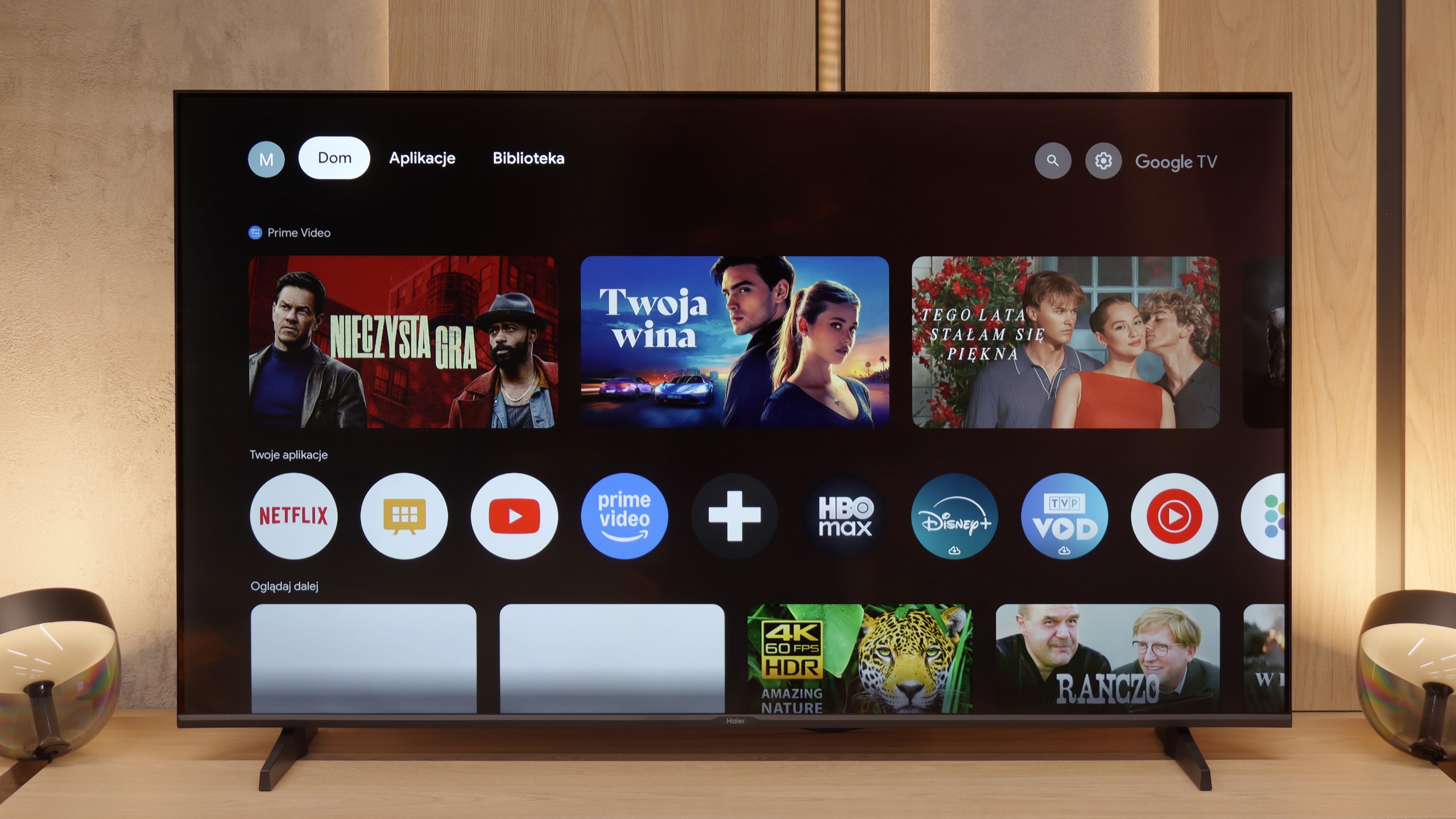
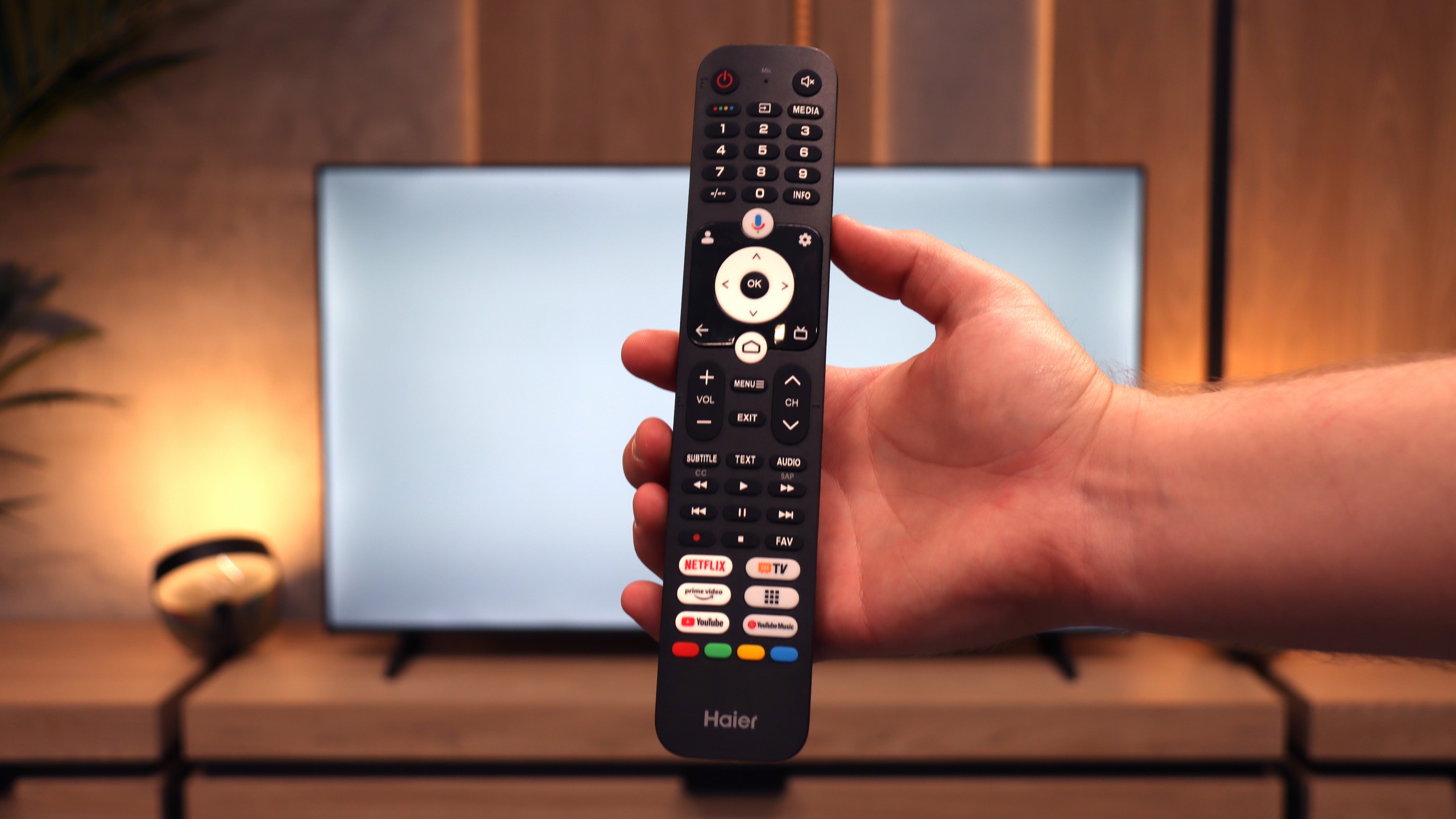
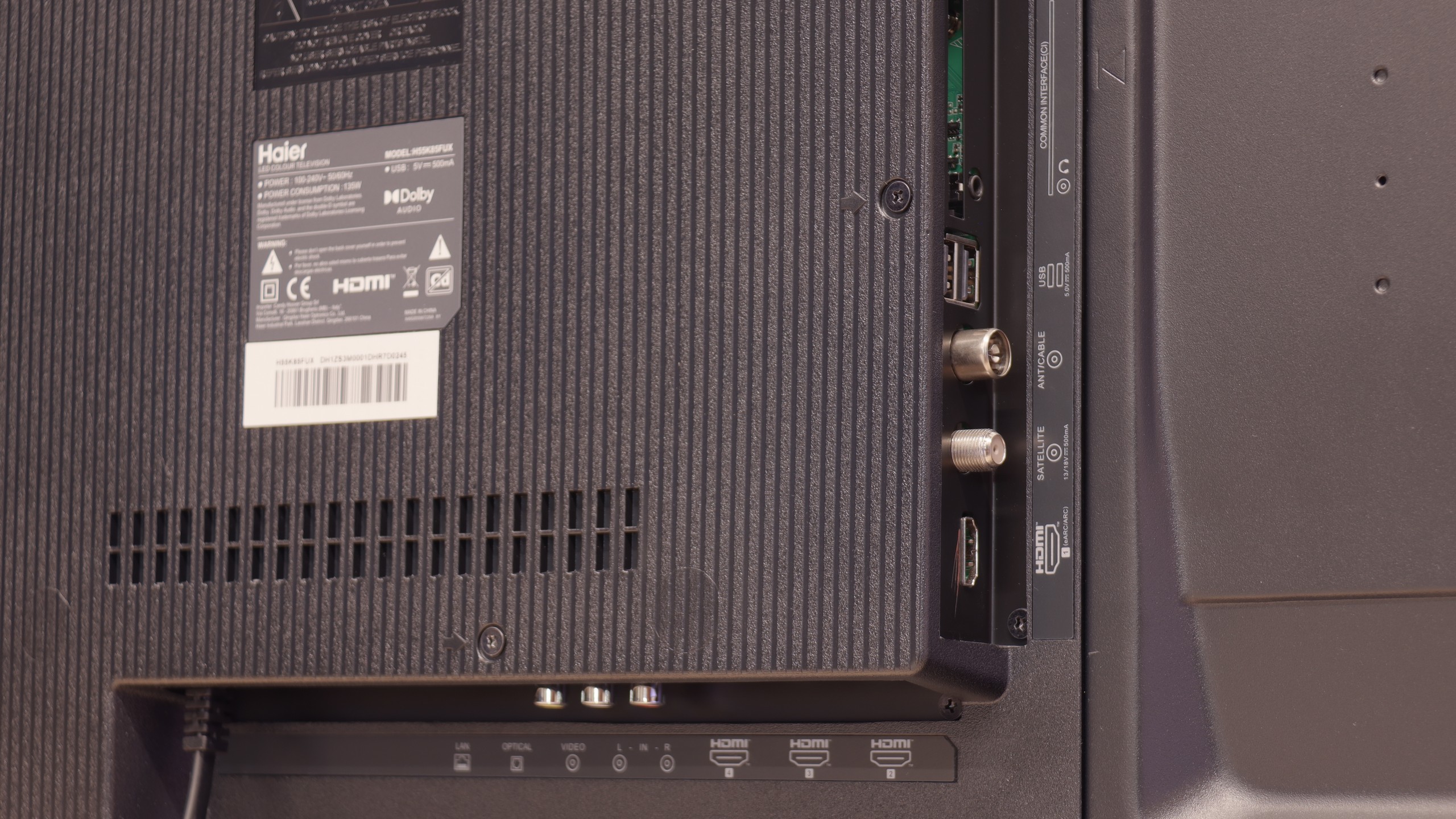
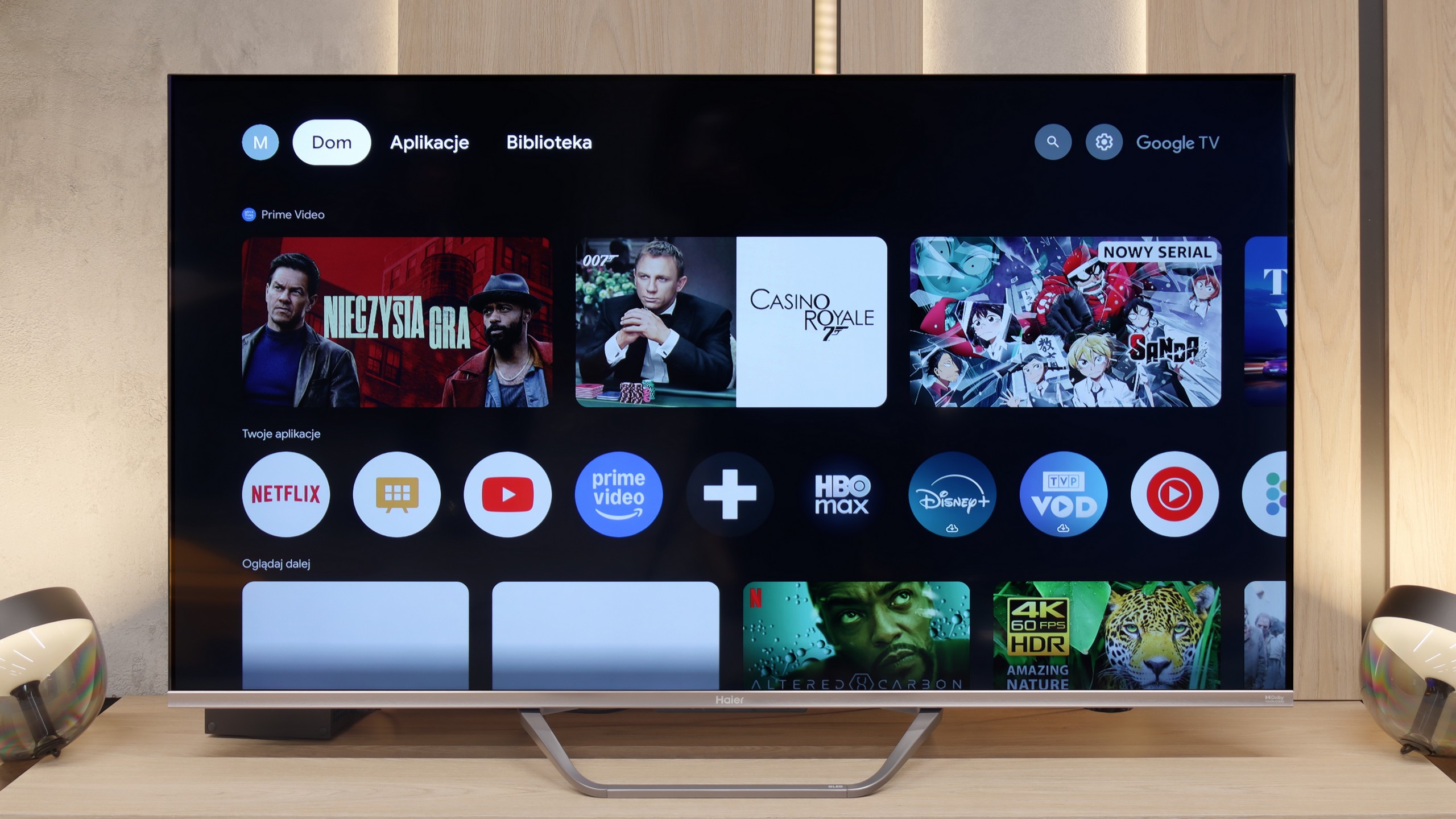
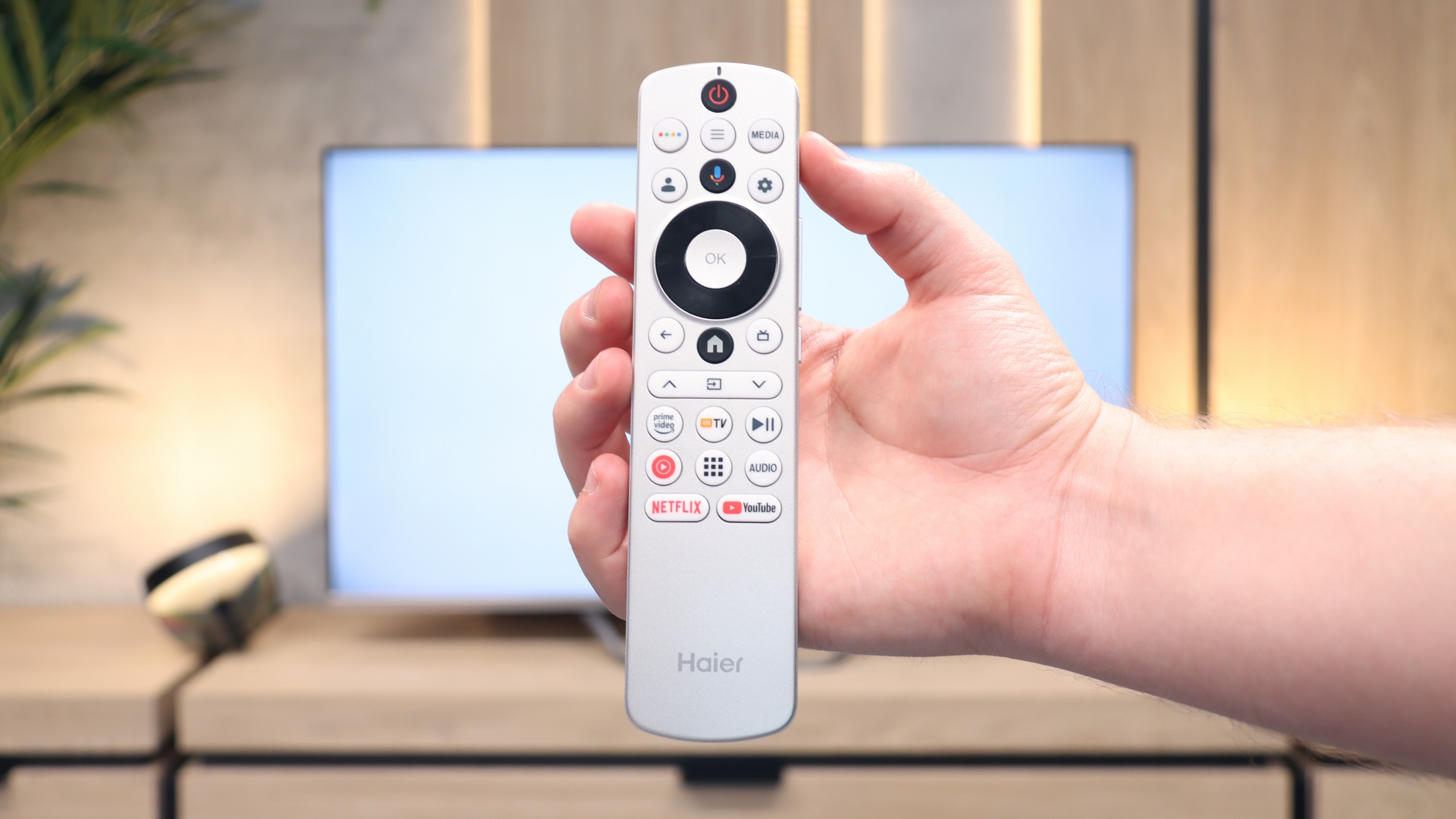

GoogleTV on Haier K85F
The heart of the television is the Google TV system, which in theory should be a huge advantage. Access to thousands of apps and a wealth of features are promises we are familiar with. Unfortunately, in Haier's execution, this is one of the worst implementations of this software we have encountered. The system operates painfully slowly, and the interface notoriously freezes. However, the real nightmare is the incorrect and often downright comical translations of some menu options, making it difficult to figure out what is being referred to at times. To make matters worse, during our testing, we couldn't get the AirPlay feature to work at all.
Classic Features on Haier K85F
Let's move on to the classic functions and ports, because the story here is even more interesting. A plus is definitely the rich array of ports, including four HDMI connections and the increasingly rare mini-jack headphone output. Unfortunately, the television does not offer either USB recording or Picture-in-Picture mode. However, the real ordeal begins with the remote. Our initial attempts to pair it via Bluetooth to activate radio (RF) control and voice functions ended in total failure. After dozens of attempts, we were convinced it was simply a manufacturing defect. And then the surprise: after a long struggle, we discovered that the remote can be paired, but it must be done from the native Google TV settings, completely bypassing Haier's dysfunctional system overlay. This is a perfect example of how terrible software can ruin basic functionality. Oh, and one more thing. In the box... there weren't even batteries for the remote.
SmartTV on Haier Q80FUX: GoogleTV
First up, let's take a look at the smart layer, which in the Q80FUX is managed by the Google TV system. This is theoretically a huge advantage, providing access to an incredible library of apps, making it easy to cast from mobile devices, and offering convenient voice search. Unfortunately, like in other models from this brand that we've tested, the implementation of this platform leaves much to be desired. It’s not even about drastic freezes or delays in navigation, but rather a festival of minor bugs, shortcomings, and terrible translations in the menu. Because of this, it's hard to consider "Google TV" in Haier's version on par with what we know from Sony or TCL receivers, even though the same, proudly sounding name is on the box.
Classic Features
Moving on to the classic, functional features of the TV, the device's performance does not improve at all. The only thing worth praising is the presence of Bluetooth connectivity and an unusual but handy relic of the past in the form of an analogue headphone jack output. Apart from that, it's hard to find anything that would excite us. Due to the problematic software, the receiver (like its predecessors in our tests) was unable to find any terrestrial TV channels, even though other TVs connected to the same installation had no such issues. The remote control is also strange – its design may appeal to some, but due to the lack of a numeric keypad and the absurd placement of some buttons on the side edge, it definitely cannot be called senior-friendly.
Playing files from USB
9.4/10
9.6/10
Supported photo formats:
Maximum photo resolution:

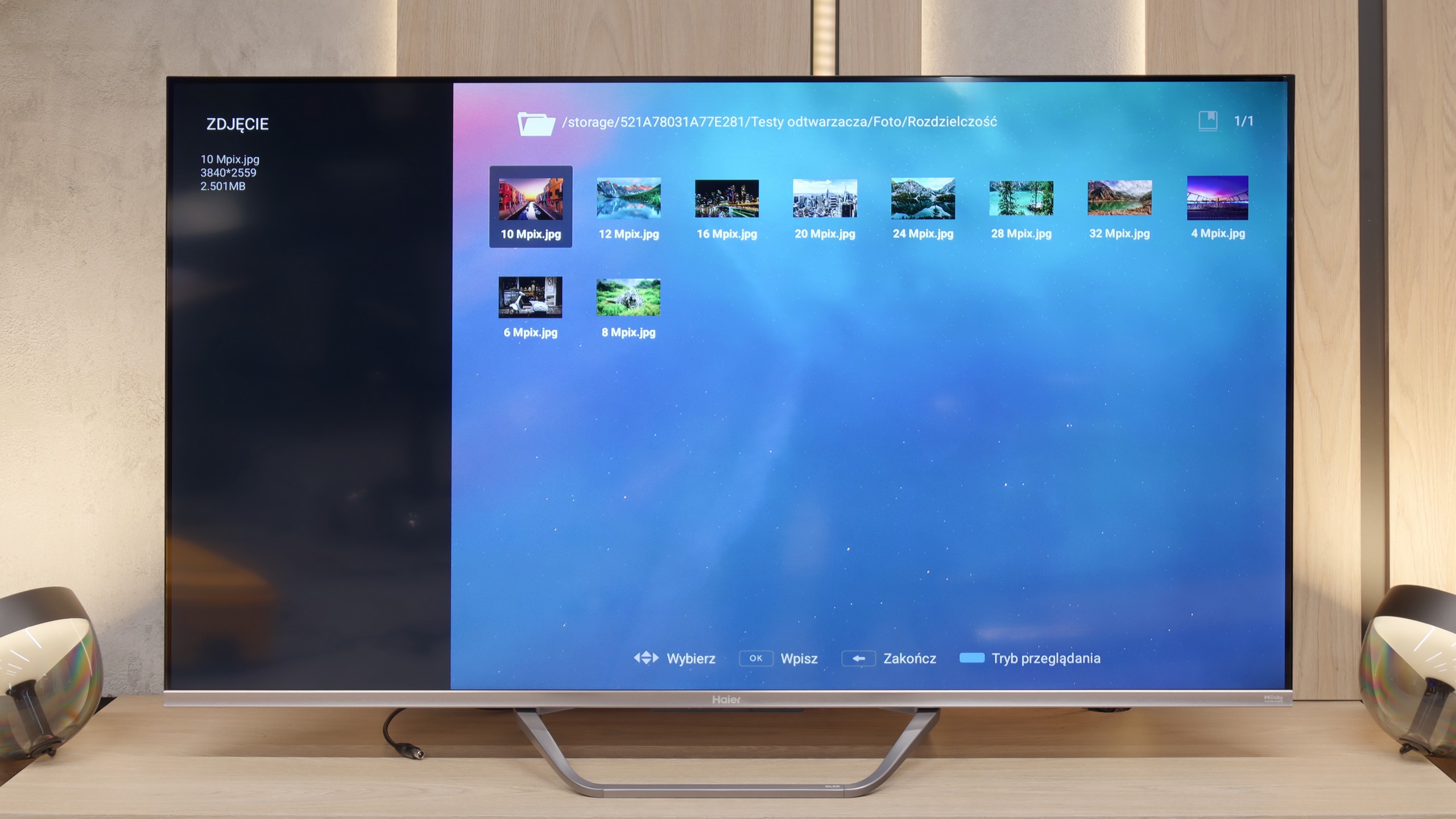
After all our complaints about the unfinished software, the moment came when we were absolutely shocked. It turns out that within this buggy and slow-running system, there is a function that works almost perfectly and puts industry veterans to shame. We are talking about the built-in media player for USB drives. It is a true multimedia powerhouse that played practically every video format we threw at it without the slightest hiccup – from the most popular to the completely niche. Haier, a newcomer to the TV market, has achieved something that many manufacturers with decades of experience have struggled with for years. Who knows, perhaps it was originally intended as a reliable player for conference rooms? Regardless of its origins, the result is outstanding!
We must admit that after a series of setbacks we faced in assessing the overall implementation of the Google TV system, we approached the media player test with a fair bit of caution. Meanwhile, in this one specific aspect, the Q80FUX served us a real surprise. The built-in app for handling files from USB drives works simply brilliantly. This software component seems to be completely immune to the issues plaguing the rest of the system, opening practically all the most important and popular video file formats that we threw at it.
Apps
9.6/10
9.6/10














































Sound
4.8/10
5.5/10
- Maximum volume83dB84dB
- Dolby Digital Plus 7.1
- Dolby True HD 7.1
- Dolby Atmos in Dolby Digital Plus (JOC)
- Dolby Atmos in Dolby True HD
- DTS:X in DTS-HD MA
- DTS-HD Master Audio
When it comes to sound, the review will unfortunately be very short. The biggest advantage of the built-in speakers of the K85F is that they simply exist and produce sound. Other than that, the sound is completely flat, lacking any bass and just anemic. Yes, on the TV's box we will find the Dolby Atmos logo, but against the physical capabilities of these drivers, it is a feature that exists only on paper. Therefore, the verdict can only be one: when planning to purchase this TV, a soundbar should immediately be added to the budget.
When it comes to "acoustic experiences," the Haier Q80FUX seems to adhere to the principle that sound is simply meant to be. And it is – that's about all that can be said for it. The built-in speakers produce sound in an extremely flat manner, lacking character, and most importantly, they are missing any clear bass foundation. A slight consolation is the fact that the television supports the Dolby Atmos format. However, let's be honest: to realistically take advantage of the benefits of this codec and hear the promised space, passive decoding capability is simply not enough. Connecting an external home theatre system or at least a decent soundbar is not just a recommendation in this case; it's an absolute necessity.
Sound Quality Test
Acoustic Measurements
83dBC (Max)
75dBC
84dBC (Max)
75dBC
